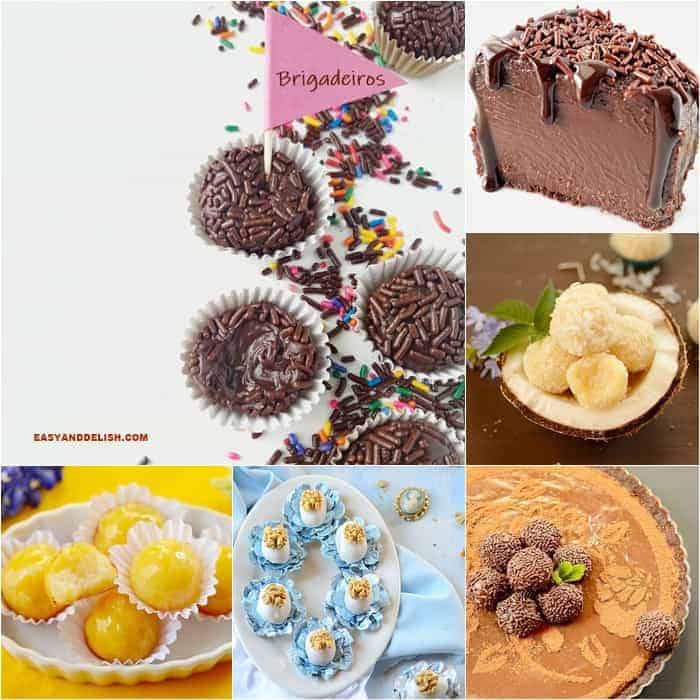90+ Authentic or Traditional Brazilian Foods that are mouthwatering, including appetizers, dinners, desserts, and drinks. Get their recipes!

These Traditional Brazilian Foods are part of a mosaic of influences from many different cultures: Brazil's native peoples (several tribes), European (Portuguese, Italian, Spanish, Dutch, German, and Polish), African, Asian (mostly Japanese), and also Middle-Eastern (Lebanese and Syrian).
These authentic Brazilian appetizers, dinners, desserts, and drinks also vary from one region to another, reflecting the country's diverse backgrounds and vast territory.
WATCH THE VIDEO ON HOW TO MAKE GRILLED PICANHA STEAK, one of our most traditional Brazilian foods!
Perhaps the most striking trait about Brazilian cuisine is that somehow a unified national culinary identity took shape, while distinct differences remained at the regional level, where the influence of each of the above peoples was the greatest. It's like a beautiful, colorful quilt!Table of Contents
- 1 Traditional Brazilian Foods by Denise Browning
- 2 Overview of Traditional Brazilian Meals
- 3 Traditional Brazilian Savory Foods
- 4 Traditional Brazilian Sweets
- 5 Traditional Brazilian Drinks
- 6 Regional Brazilian Foods
- 7 Authentic Brazilian Meals in Restaurants
- 8 Brazilian Daily Meals & Staples
- 9 Conclusion
- 10 Traditional Brazilian Food FAQs
- 11 90+ Traditional Brazilian Foods That Are Mouthwatering
Traditional Brazilian Foods by Denise Browning
Overview of Traditional Brazilian Meals
Now, let's continue to an overview of authentic Brazilian food or cuisine.
First of all, let's look at typical ingredients that are heavily used daily in Brazilian cooking.
Typical Ingredients:
- Nuts -- cashews, Brazil nuts, peanuts, and pine nuts (pinhão)
- Vegetables -- cassava, yams, corn, okra; palmito (hearts of palm)
- Fruits, mostly tropical -- cashew fruit, açai, guaraná, banana, custard apple, acerola, pitanga, coconut, guava, mango, pineapple, papaya, passion fruit, coffee, pequi, and so many others
- Meats -- a large variety of seafood, poultry, pork, and beef
- Dairy -- mostly cow's milk and typical cheeses such as requeijão, coalho, Catupiry, and Minas
- Legumes -- beans (black, pinto, soybeans, garbanzo)
- Grains -- several types of rice, wheat, and cornmeal
- Grass -- sugar cane
- Others -- tapioca, palm oil (or dende)
Traditional Brazilian Foods and Drinks
Second, let's take a look at typical dishes and drinks-- some quite iconic-- created from the ingredients above. This overview also has links to almost every item's RECIPE.
Traditional Brazilian Savory Foods
| Name | Image | Description |
|---|---|---|
| Feijoada | 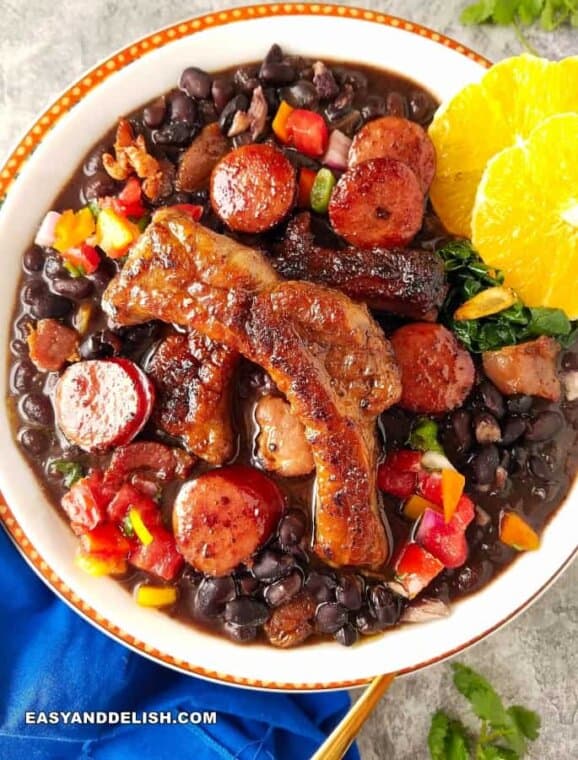 | Black bean and pork stew -- this is widely considered to be the national dish of Brazil. |
| Tapioca crepes | 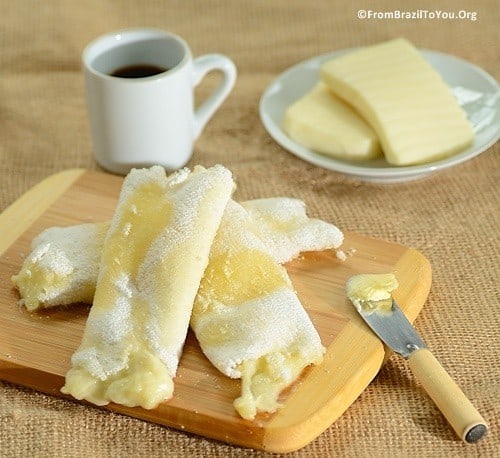 | Crepes made from tapioca flour, water, and salt, with either savory or sweet fillings, inherited from Brazil's native tribes. |
| Beans and rice | 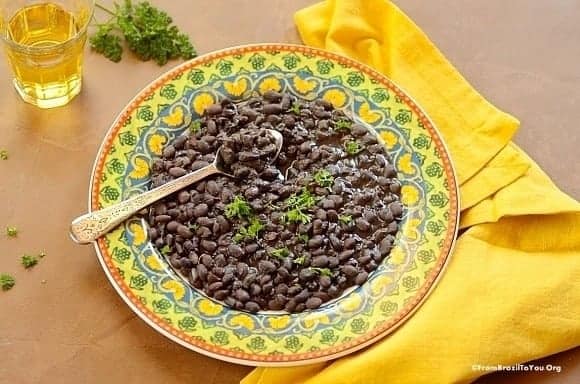 | A staple in most of the country. |
| Moqueca | 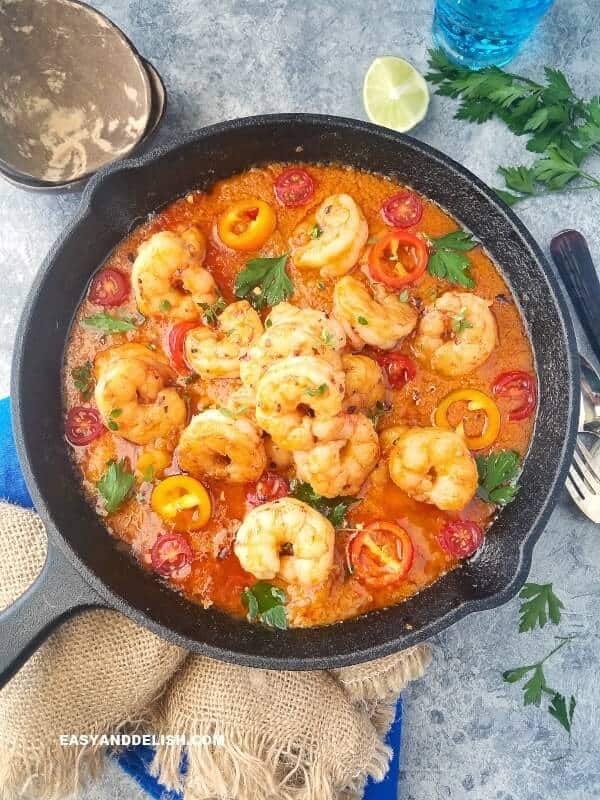 | A seafood and vegetable stew typical of Bahia State, which was greatly influenced by Africans. |
| Churrasco | 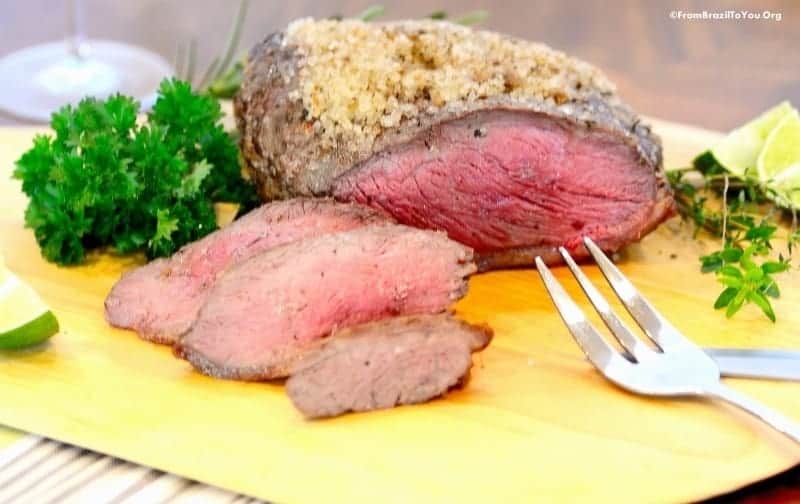 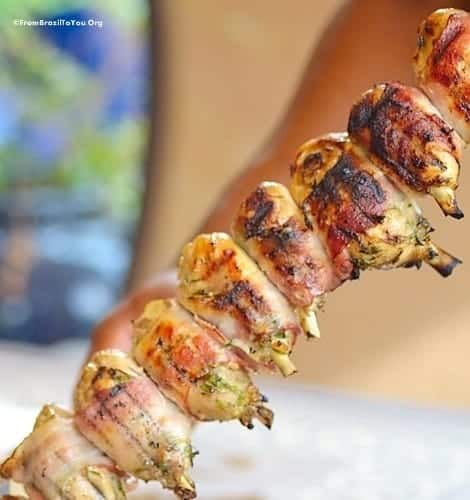 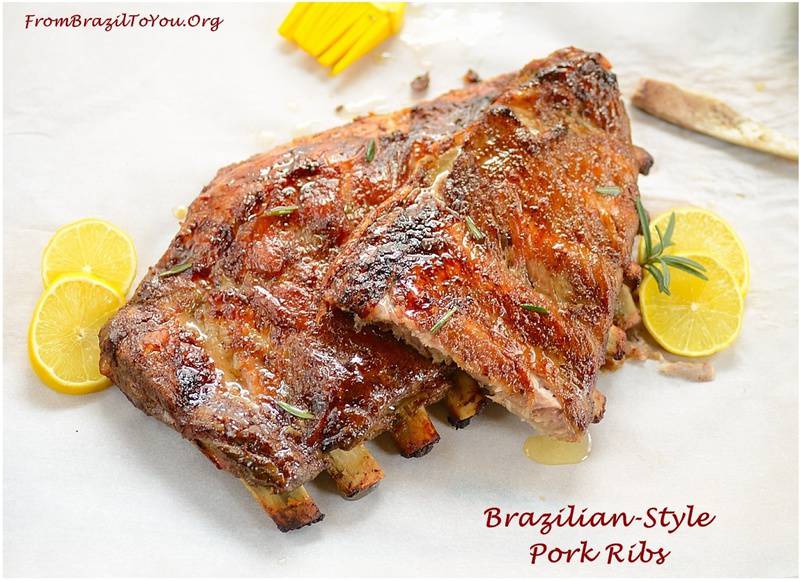 | Grilled meats-- including picanha, and others such as grilled chicken and pork ribs. |
| Pao de queijo | 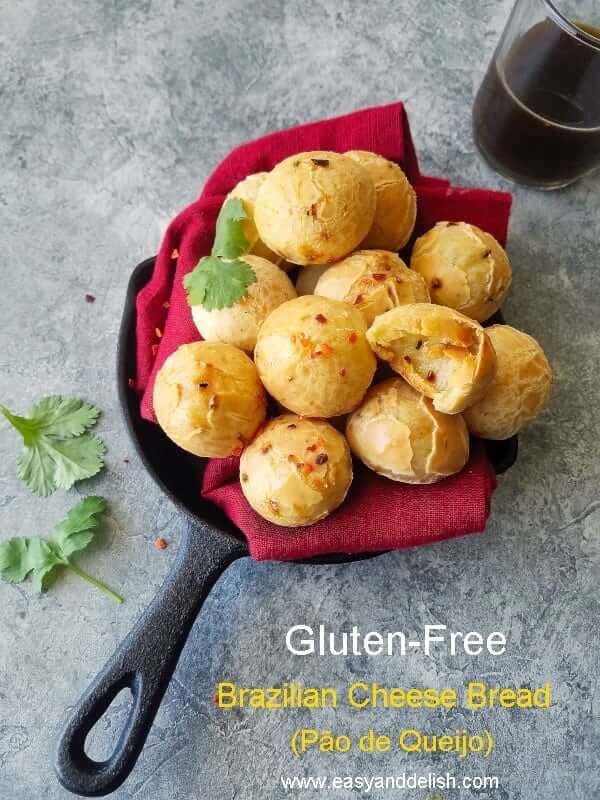 | Gluten-free cheese bread rolls made from tapioca flour. |
| Coxinha | 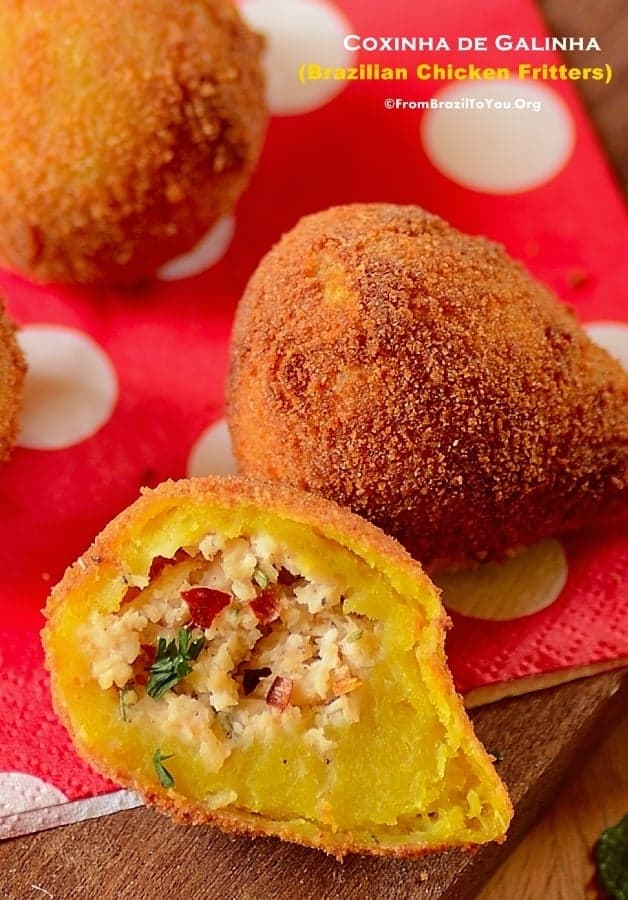 | Deep-fried chicken fritters very popular at snack bars, parties, and as a street food. |
| Farofa | 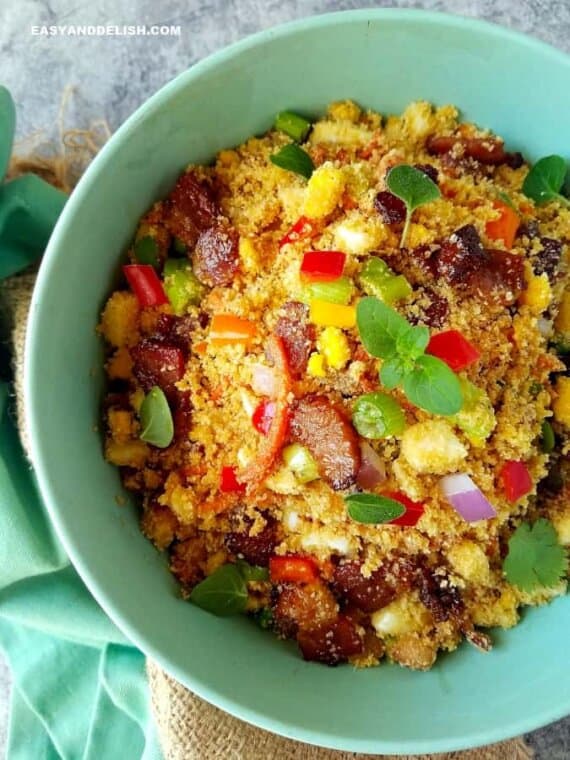 | Seasoned manioc (cassava) flour. |
| Bacalhau Quatro Queijos | 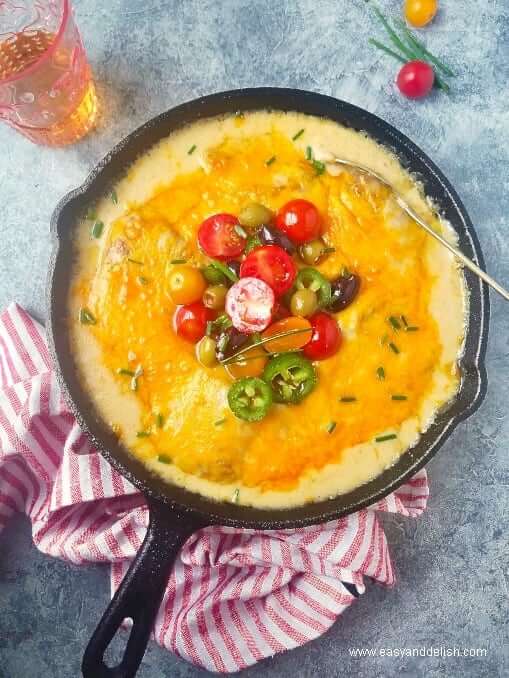 | Baked cod in Cheese sauce. |
| Cuscuz | 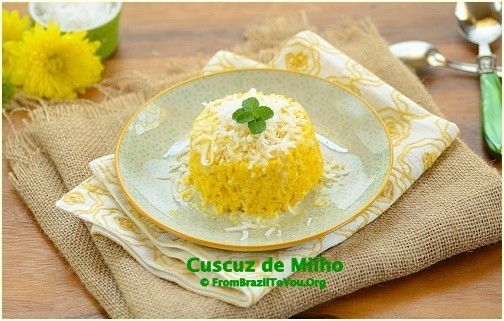 | Steamed cornmeal served with a variety of toppings, either savory or sweet. |
| Galinhada | 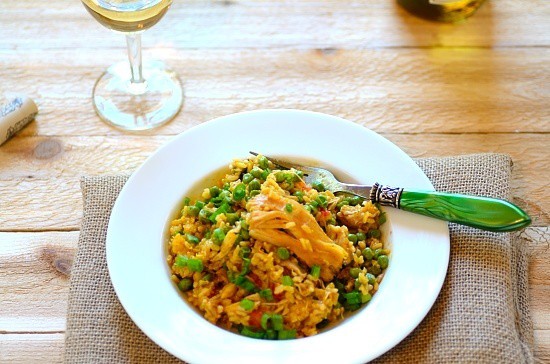 | Saffron rice with chicken and vegetables. |
| Pizza | 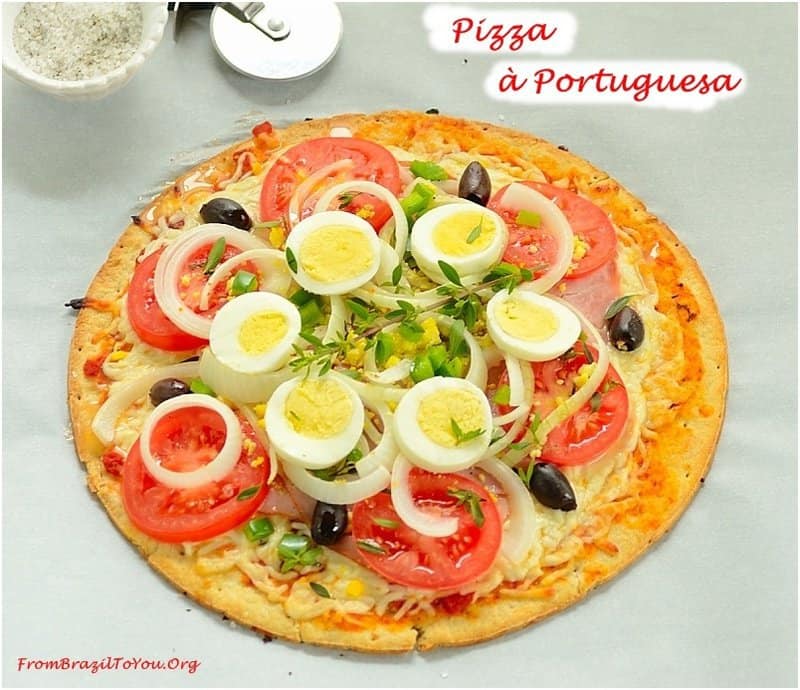 | A legacy of Italian immigrants, who adapted it to their new Brazilian setting. Thin crust pizza baked in a wood-fired oven with little or no sauce, but with a wide range of toppings, either savory or sweet. |
| Quibe (Kibbeh) | 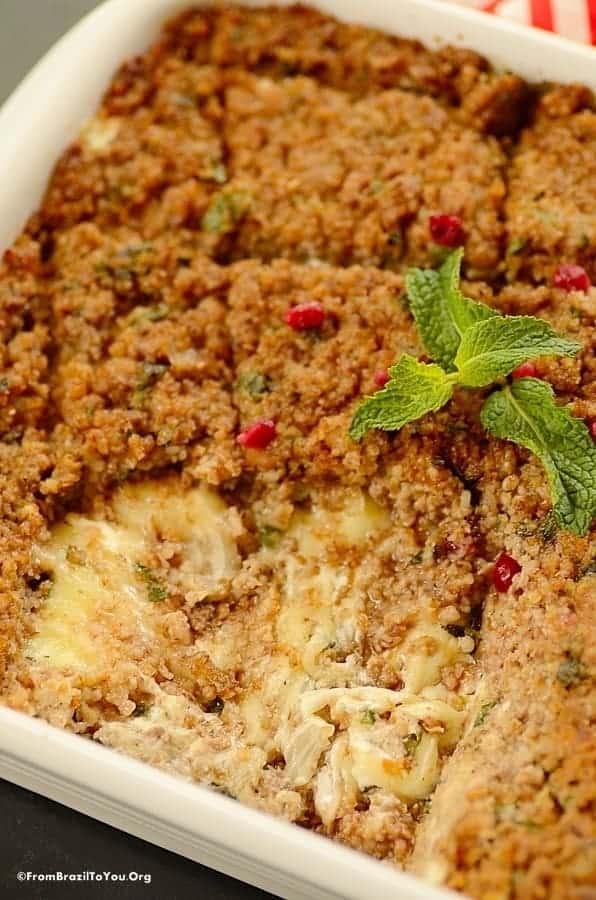 | Bulgur wheat fritters, from Arab cuisine that also can be made into a baked casserole with requeijao. |
| Requeijao |  | Brazilian cream cheese. |
| Pamonha (chunky tamal) | 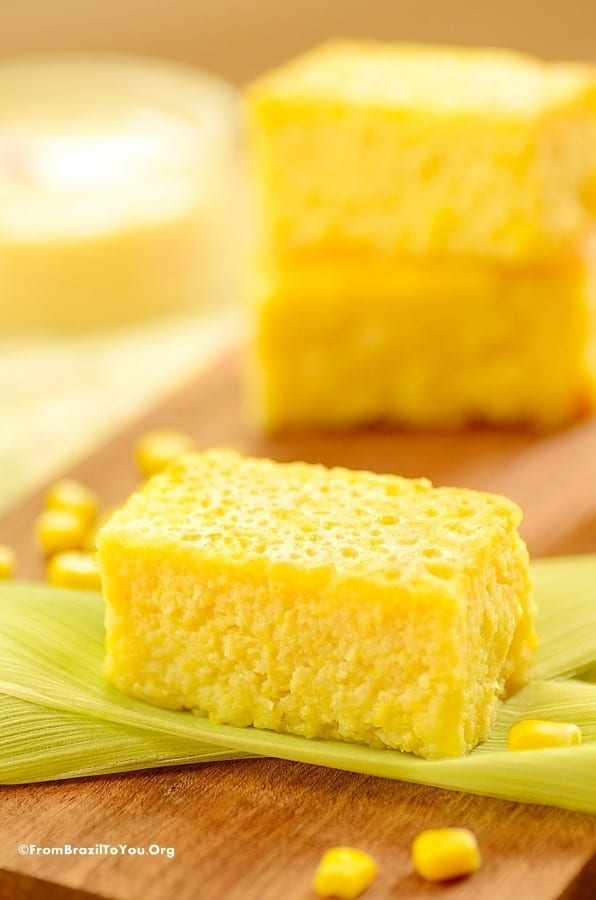 | Yellow corn cake wrapped in fresh corn husks and boiled (either savory with cheese and sausage, or sweet made sweetened with sugar). |
| Pastel de carne | 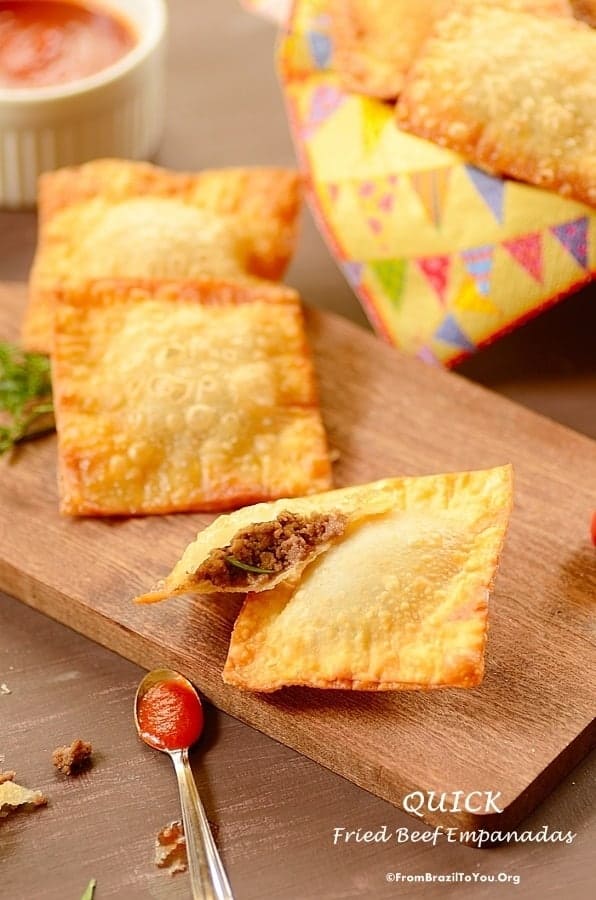 | Fried empanadas filled with ground beef. |
| Risoles | Breaded and deep-fried empanadas filled with chicken, heart of palm, or shrimp. | |
| Salpicão | 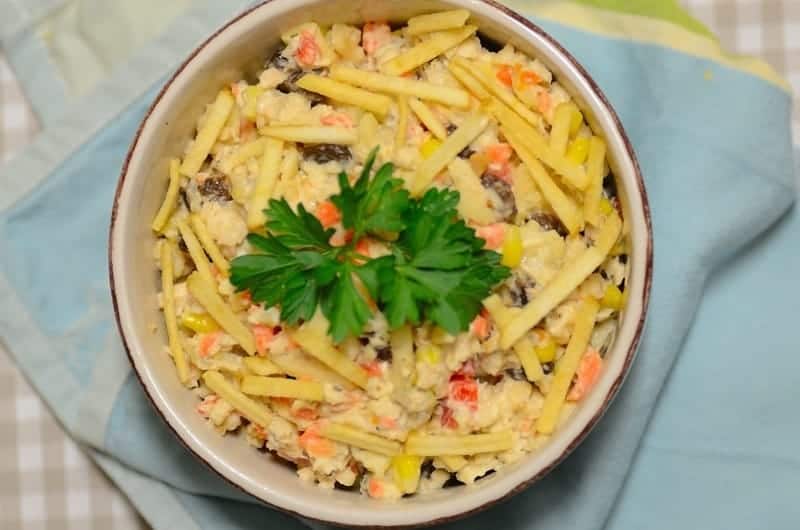 | Mayo-based chicken salad with carrots, raisins, shredded chicken and ham. |
| Acarajé | Black-eye pea fritter filled dried shrimp and a spicy creamy paste called vatapá. | |
| Aipim frito | 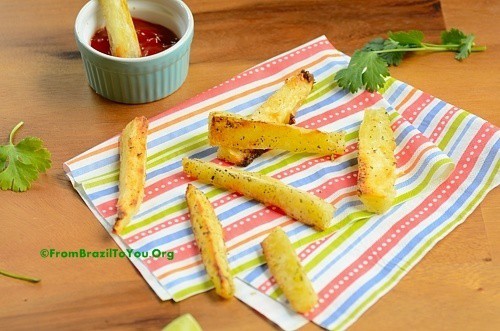 | Yuca or cassava fries. |
| Arroz com pequi | Rice with pequi fruit. | |
| Arroz de coco | Coconut rice. | |
| Arroz de forno |  | Baked rice casserole. |
| Baiao de dois | Rice, bean, and cheese stew. | |
| Banana empanada | 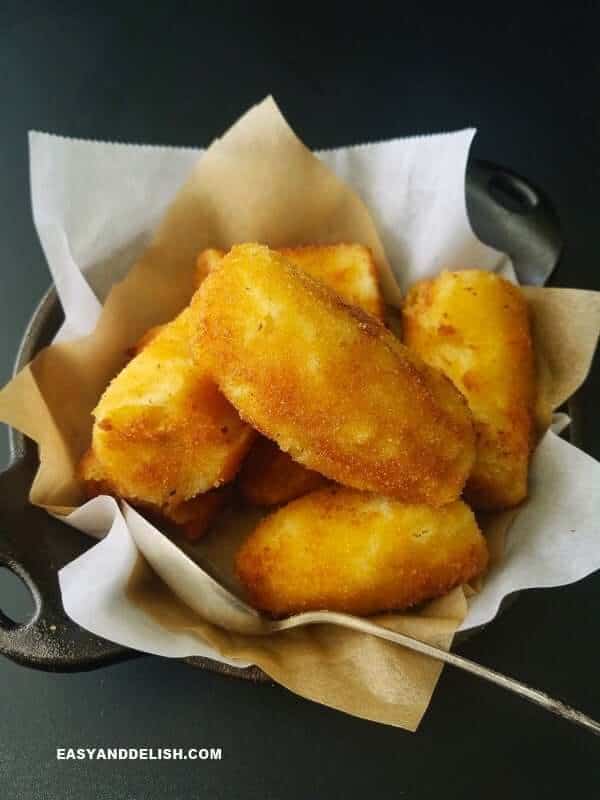 | Deep fried bananas. |
| Bauru | A type of ham and cheese sandwich. | |
| Bife à Cavalo | 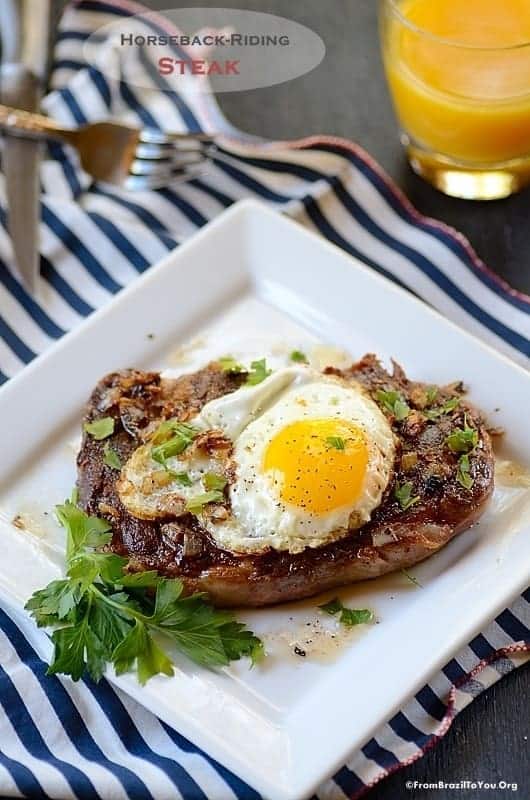 | Grilled (or sometimes deep-fried) beef steak, with fried eggs on top. |
| Biscoito de polvilho | 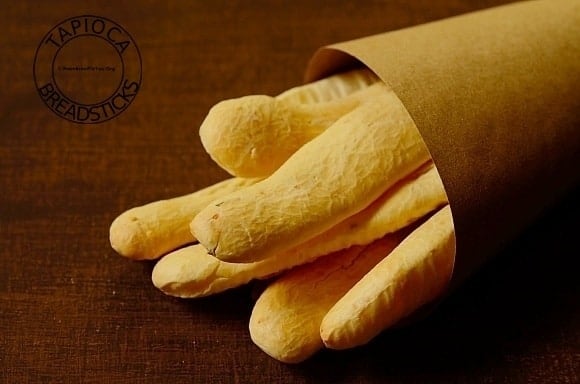 | Tapioca breadsticks. |
| Bobó de Camarão | 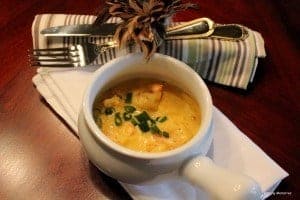 | A shrimp dish similar to a chowder, served in a puree of cassava (manioc) meal and coconut milk. |
| Bolinho de bacalhau | 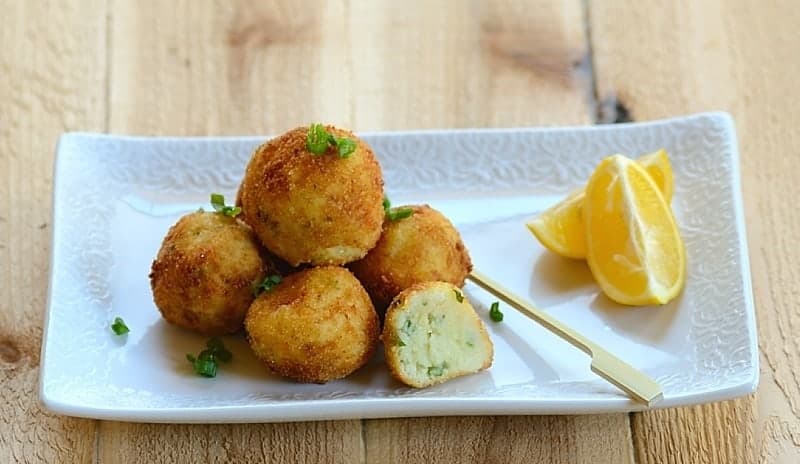 | Fried breaded cod cakes. |
| Broa de milho |  | A type of Portuguese corn bread. |
| Cachorro quente |  | Brazilian hot dogs, served with many varied toppings. |
| Camarão no leite de coco | 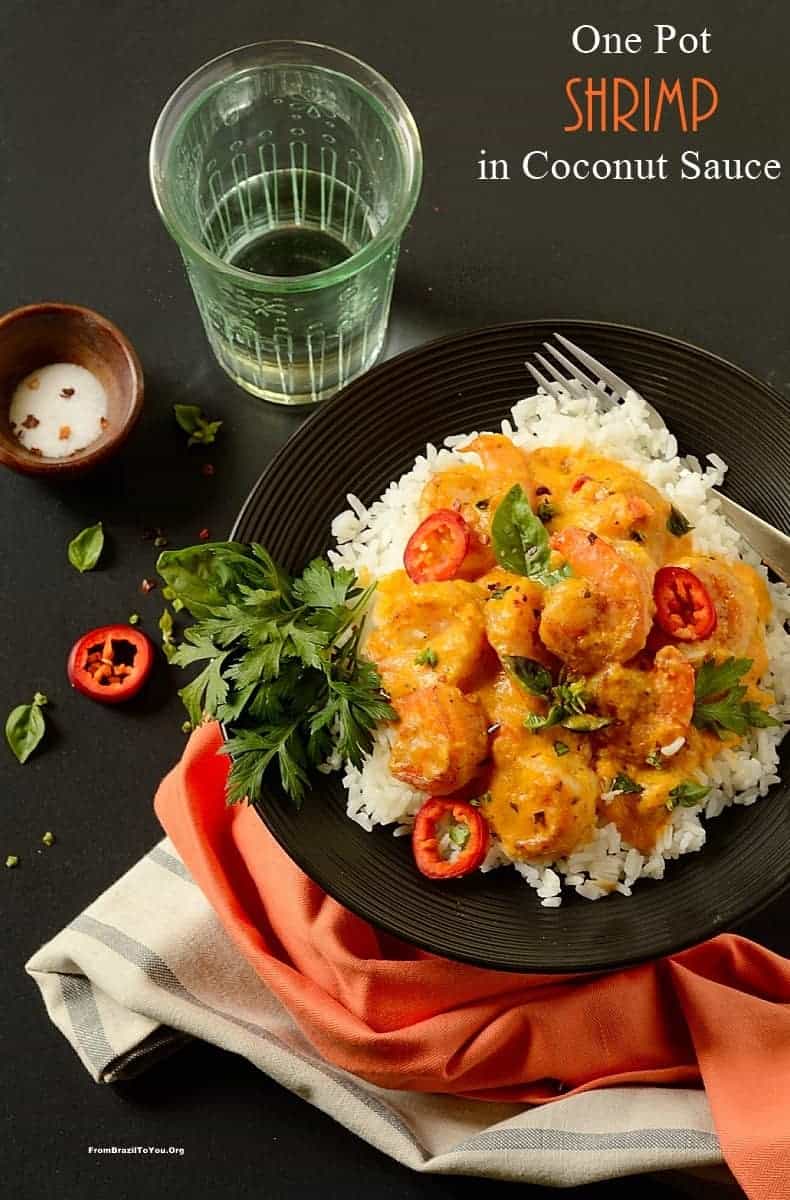 | Shrimp in coconut sauce. |
| Canja de Galinha | 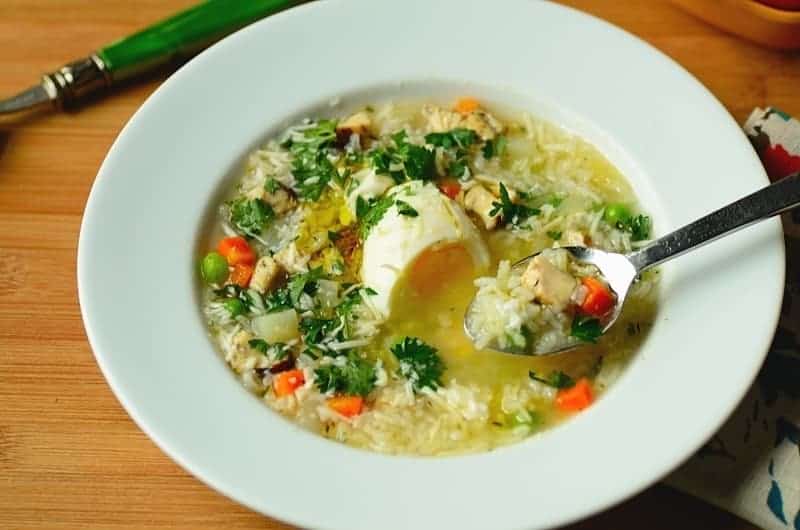 | Chicken soup with rice. |
| Carne de sol | 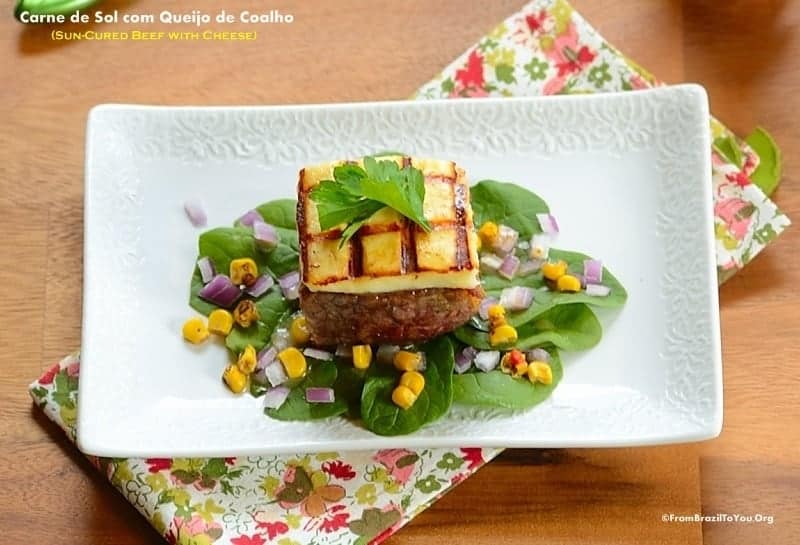 | Salt cured beef. |
| Couve a Mineira | 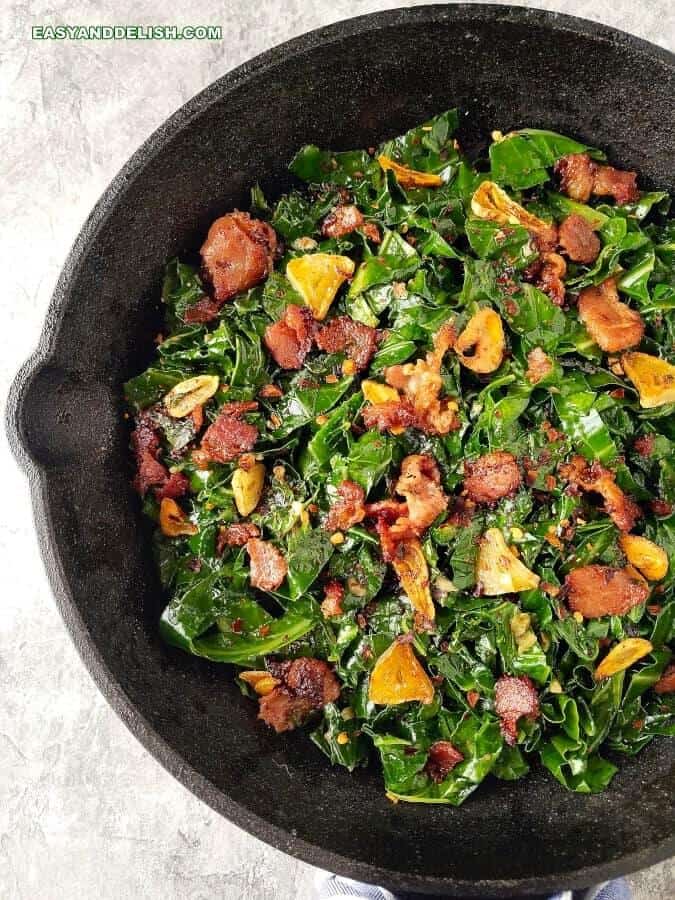 | Pan-fried collard greens. |
| Empadão | 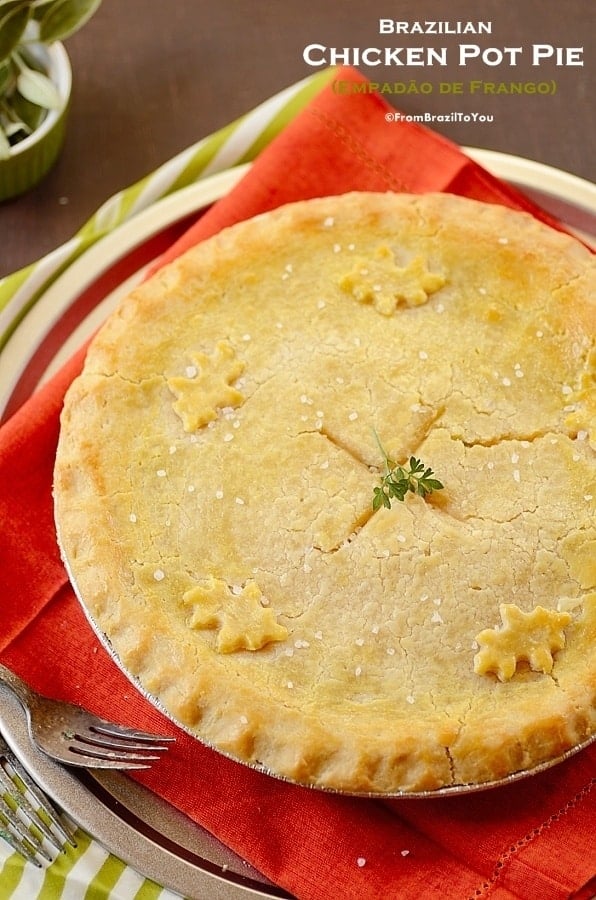 | Large chicken pot pie. |
| Ensopado de Camarão | 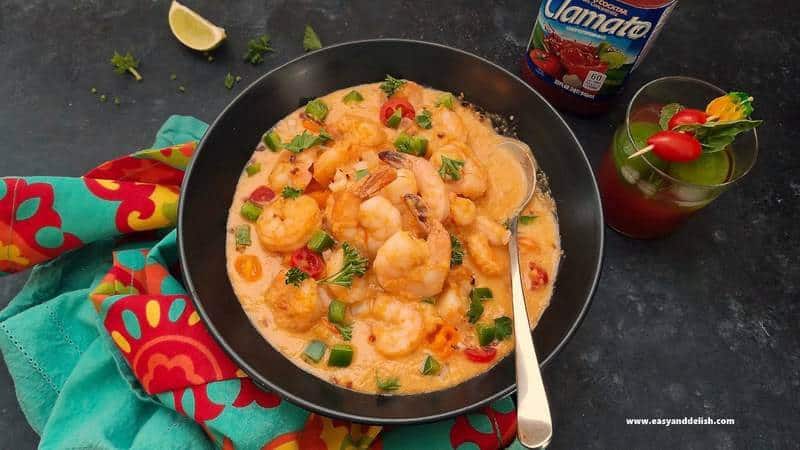 | Brazilian shrimp and vegetable stew cooked in coconut milk. |
| Estroganofe |  | Chicken Stroganoff |
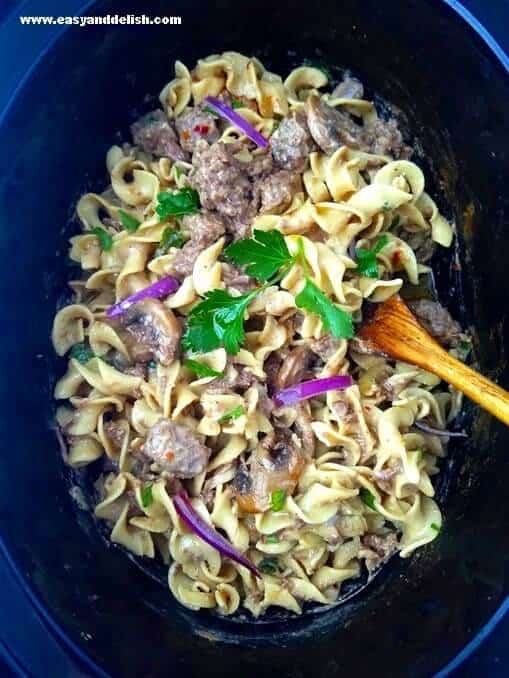 | Beef Stroganoff | |
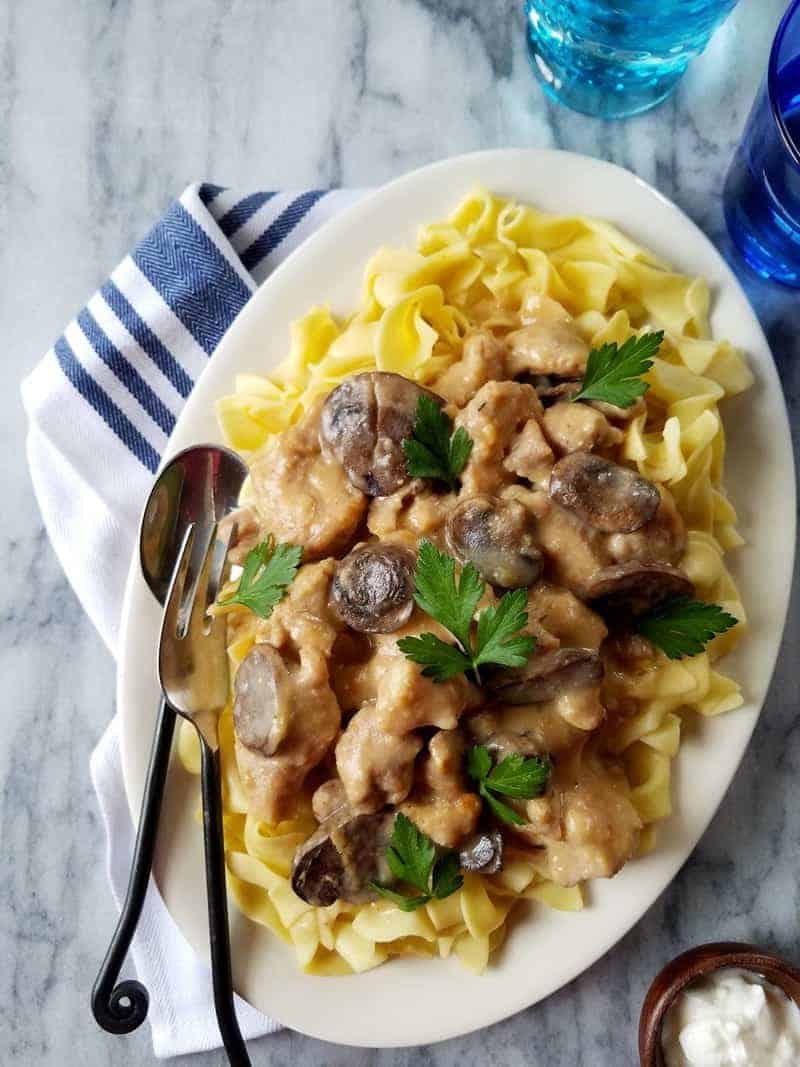 | Pork Stroganoff | |
| Escondidinho |  | Chicken shepherd's pie with yuca. |
| Feijão tropeiro | Beans with manioc (cassava) flour. | |
| Frango a Passarinho | 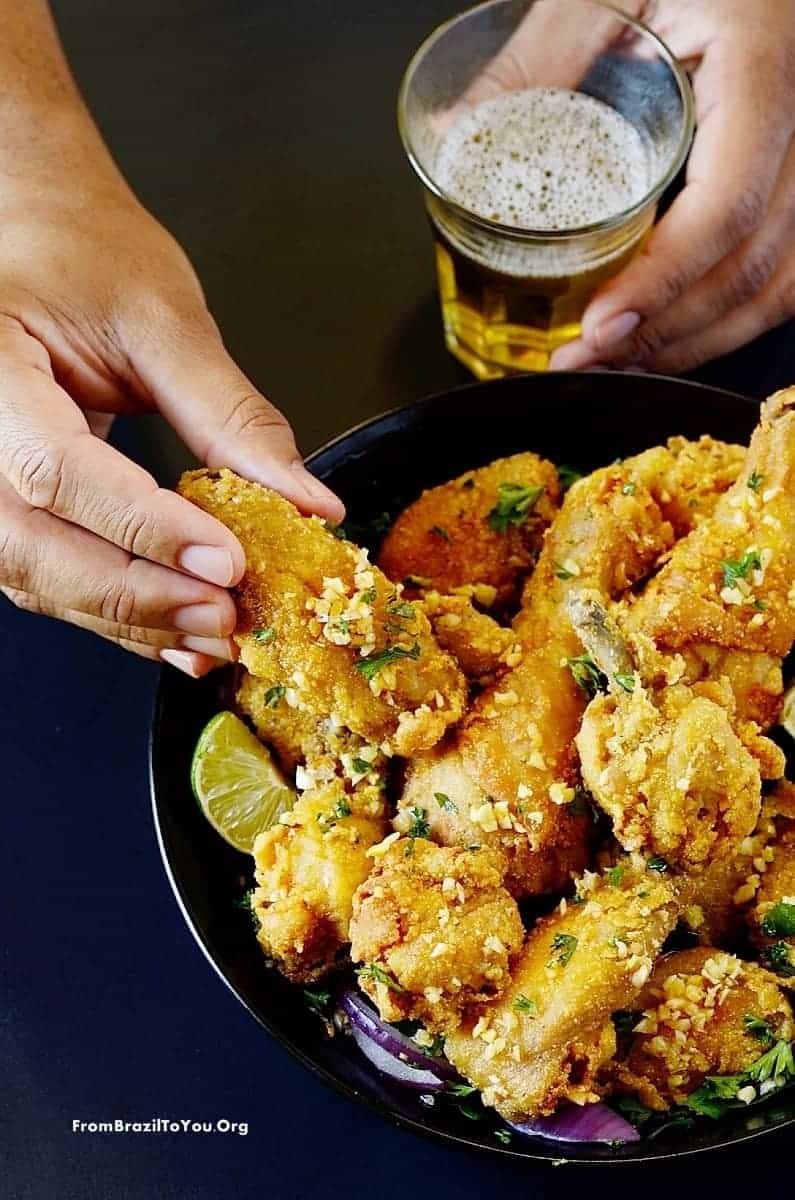 | Garlic and parsley chicken wings. |
| Fricassé de frango com batata palha | 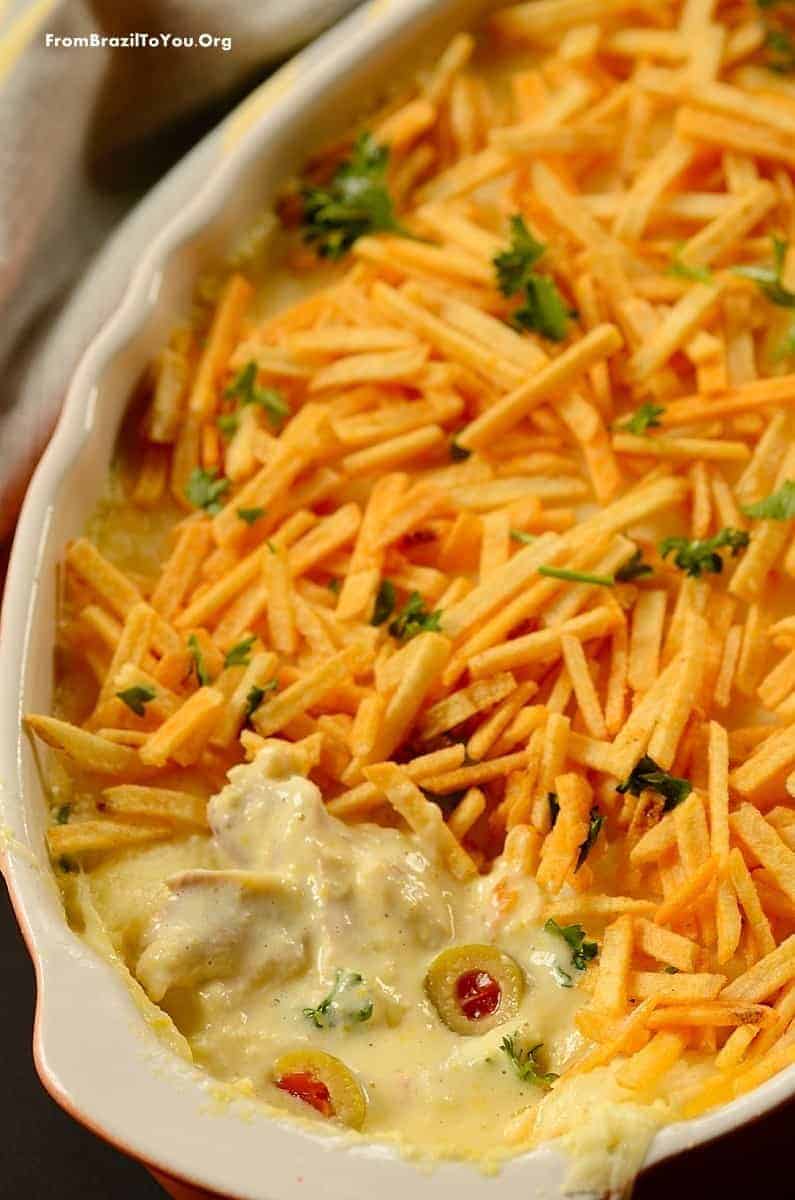 | Chicken fricasee with shoestring potatoes. |
| Macarronada |  | Brazilian mac and cheese |
| Palmito | 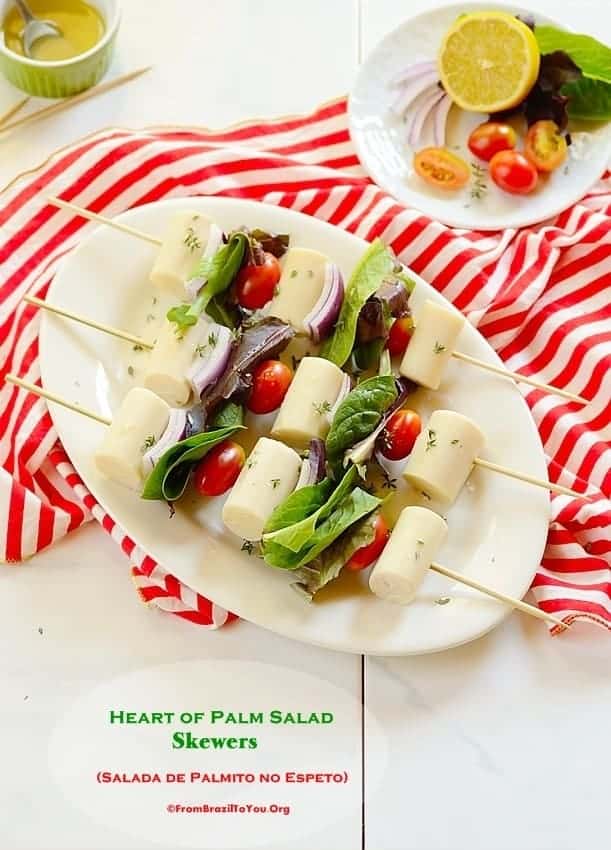 | Hearts of palm. |
| Panquecas de frango | 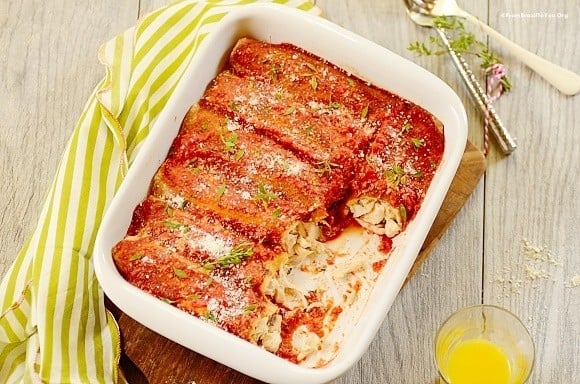 | Thin flour pancakes or crepes filled with chicken, reminiscent of enchiladas. |
| Pato no tucupi | Duck stew in a yellow sauce made from wild manioc root (cassava). | |
| Picadinho de carne | 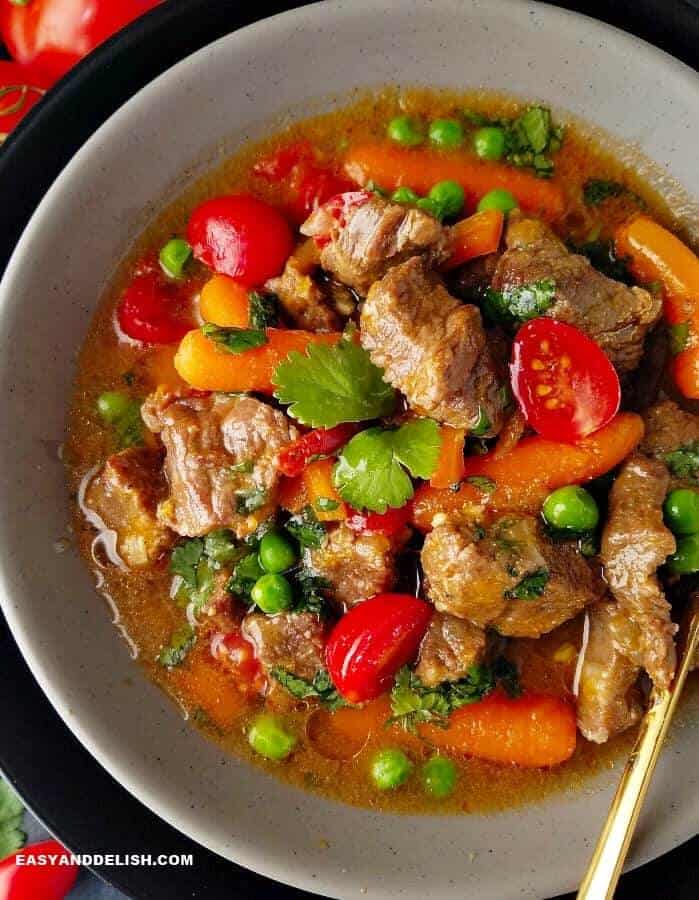 | Brazilian beef stew. |
| Salada de Batata | 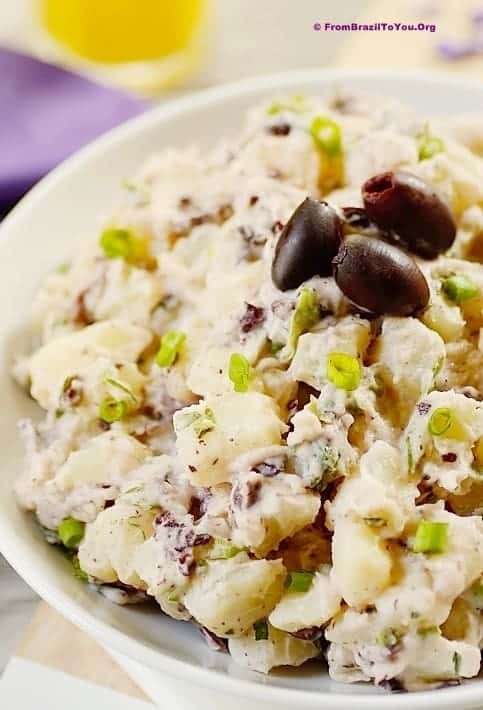 | Brazilian potato salad. |
| Sopa de Milho Verde | 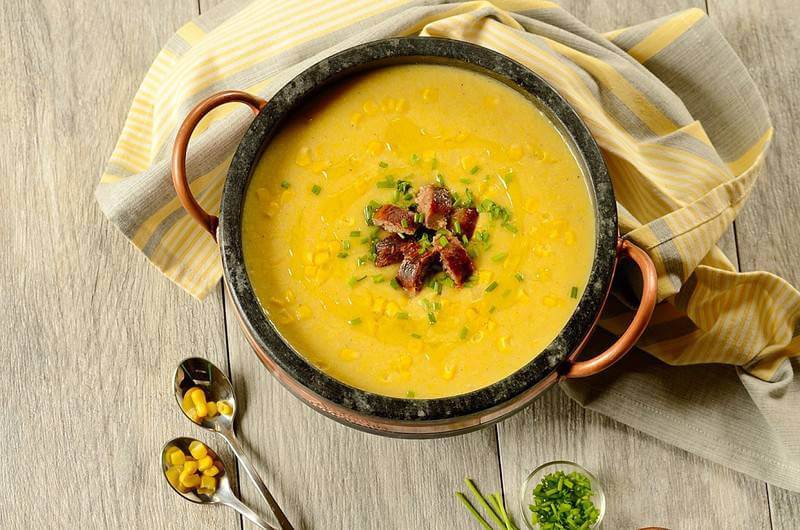 | Brazilian corn chowder. |
| Vatapa | A creamy stew made from coconut milk, palm oil, and ground peanuts, with bread as a thickener, and shrimp or other protein source. | |
| Vinagrete | A Brazilian mild pico de gallo. | |
| Yakisoba, among other noodles | Infuenced by Japanese immigrants. |
Traditional Brazilian Sweets
| Name | Image | Description |
|---|---|---|
| Brigadeiro | 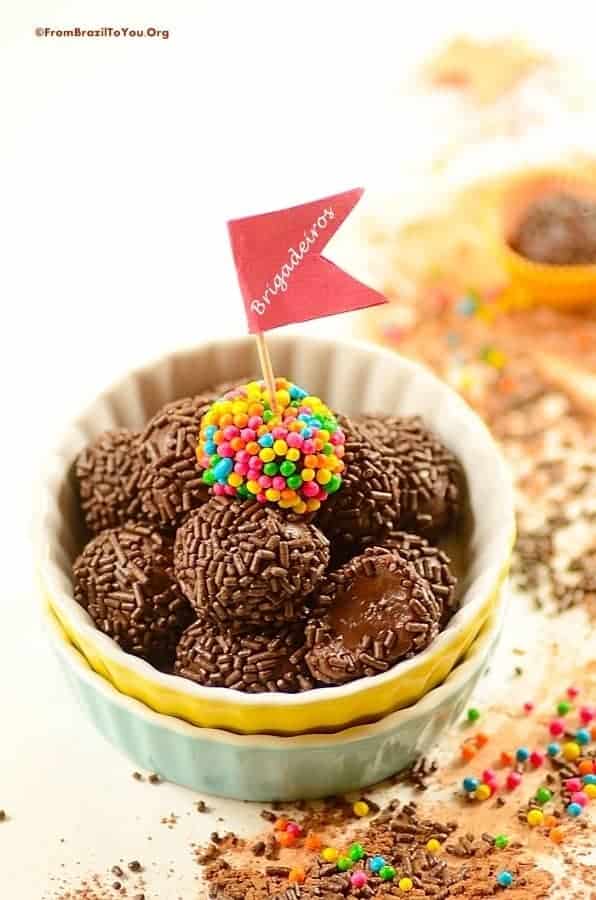 | An iconic chocolate fudge candy created in São Paulo, but beloved throughout the entire country. |
| Brigadeirão |  | A family-size brigadeiro or chocolate fudge flan. |
| Açai bowl (Açai na tigela) | 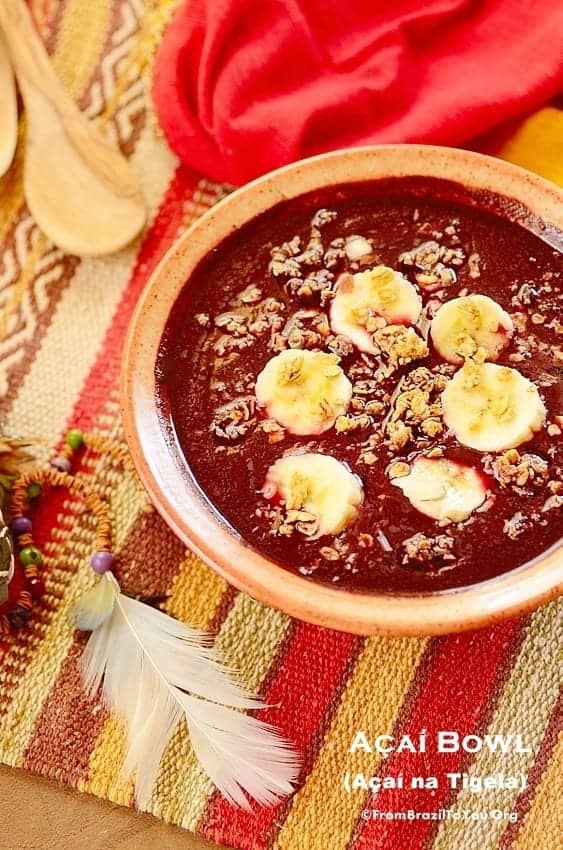 | Açai smoothie topped with bananas and granola (although there is a savory version that is served with dried fish, shrimp, and manioc flour). |
| Bolo de rolo |  | A thin multi-layer cake roll filled with melted guava paste, or made with other flavors, such as chocolate. |
| Beijinho | 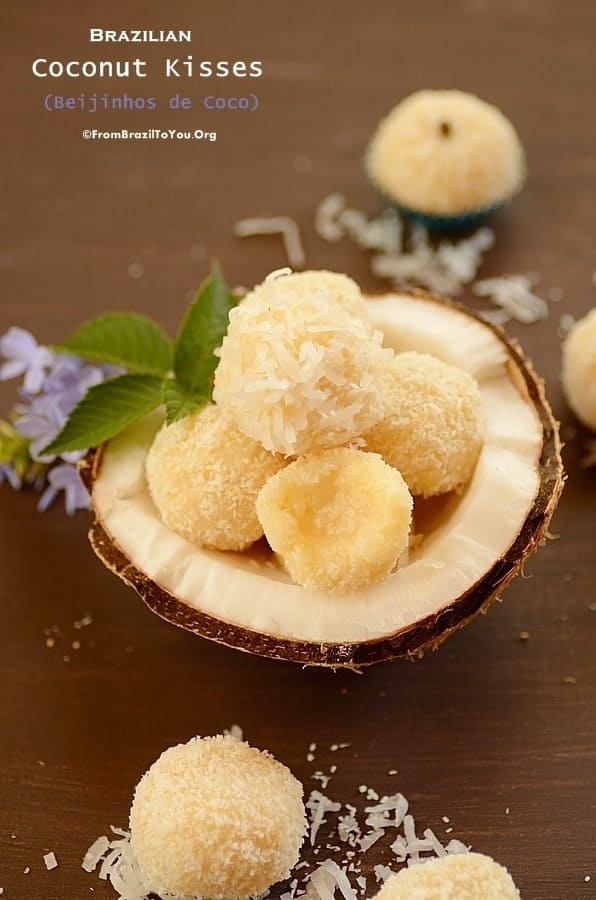 | Coconut brigadeiros. |
| Arroz doce | 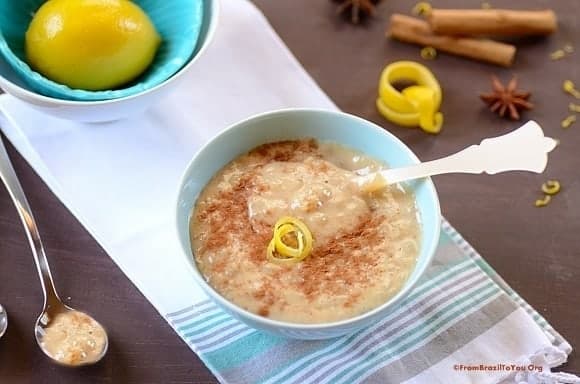 | Rice pudding topped with cinnamon. |
| Bolinho de chuva | 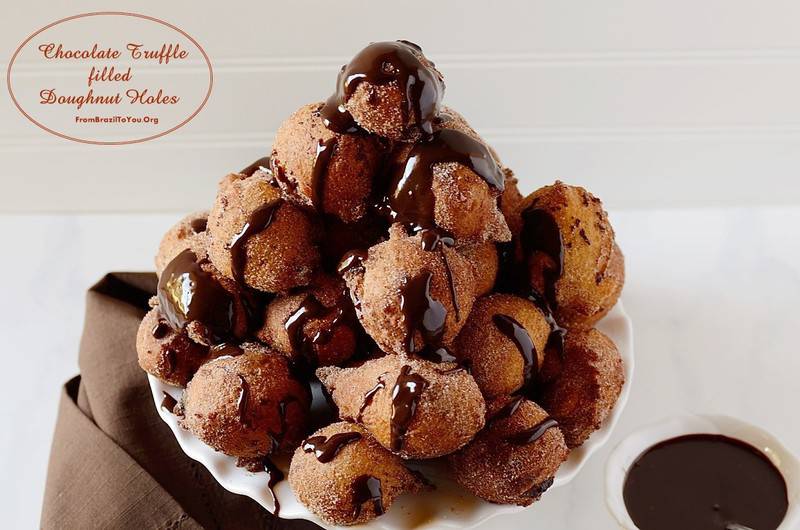 | Deep-fried doughnut holes covered in cinnamon sugar. |
| Bolo de arroz |  | Sticky rice cake made from rice flour. |
| Bolo de banana | 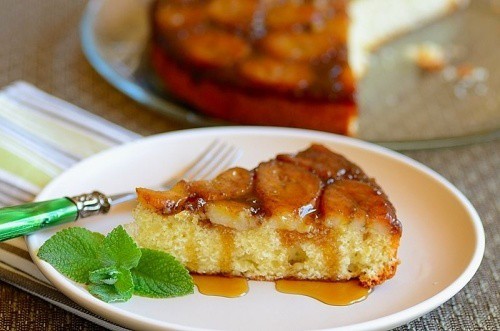 | Cinnamon spiced banana cake. |
| Bolo de cenoura |  | Cake with carrots finely pureed into the batter, fluffy and topped with chocolate ganache. |
| Bolo de coco | Mildly-sweet fluffy coconut cake. | |
| Bolo de fubá |  | Cornmeal cake. |
| Bolo de milho |  | Sweet corn cake, either fluffy or creamy. |
| Bolo de tapioca | 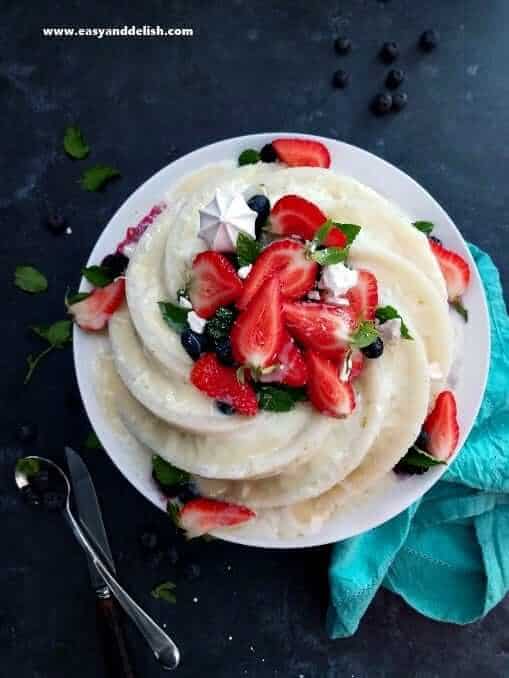 | No bake tapioca cake with coconut. |
| Canjica de milho/ Munguzá Doce | 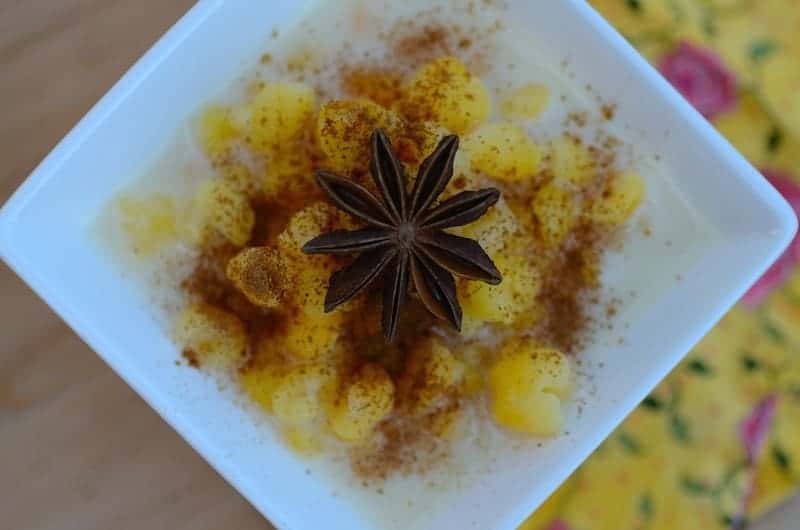 | Hominy cooked in a sweet coconut sauce. |
| Cocada de Leite Condensado | 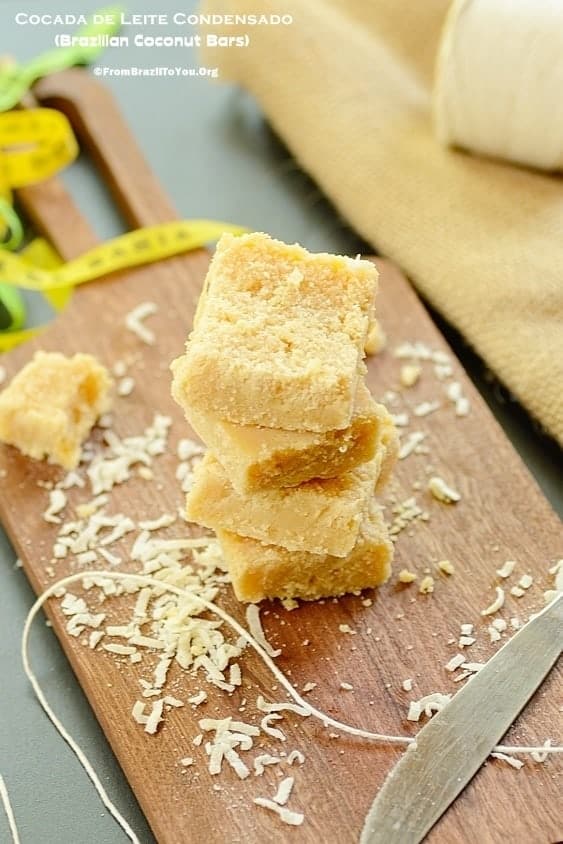 | Sweet, slightly chewy bars made with coconut flakes and condensed milk. |
| Creme de abacate |  | Eggless avocado mousse blended with sweetened condensed milk. |
| Creme de papaya com cassis | 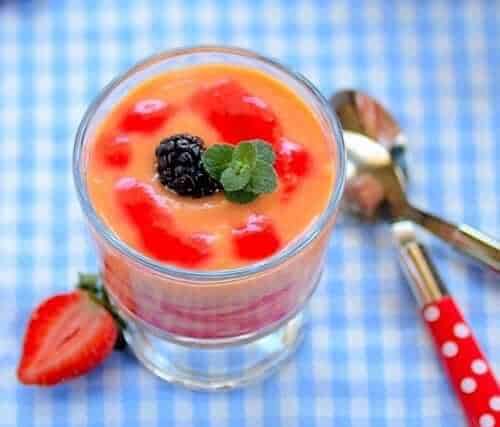 | Papaya cream with blackcurrant liqueur. |
| Cuca de Maçã |  | Traditional coffee cake topped with applies, brought by German immigrants to Brazil |
| Delícia de Abacaxi | 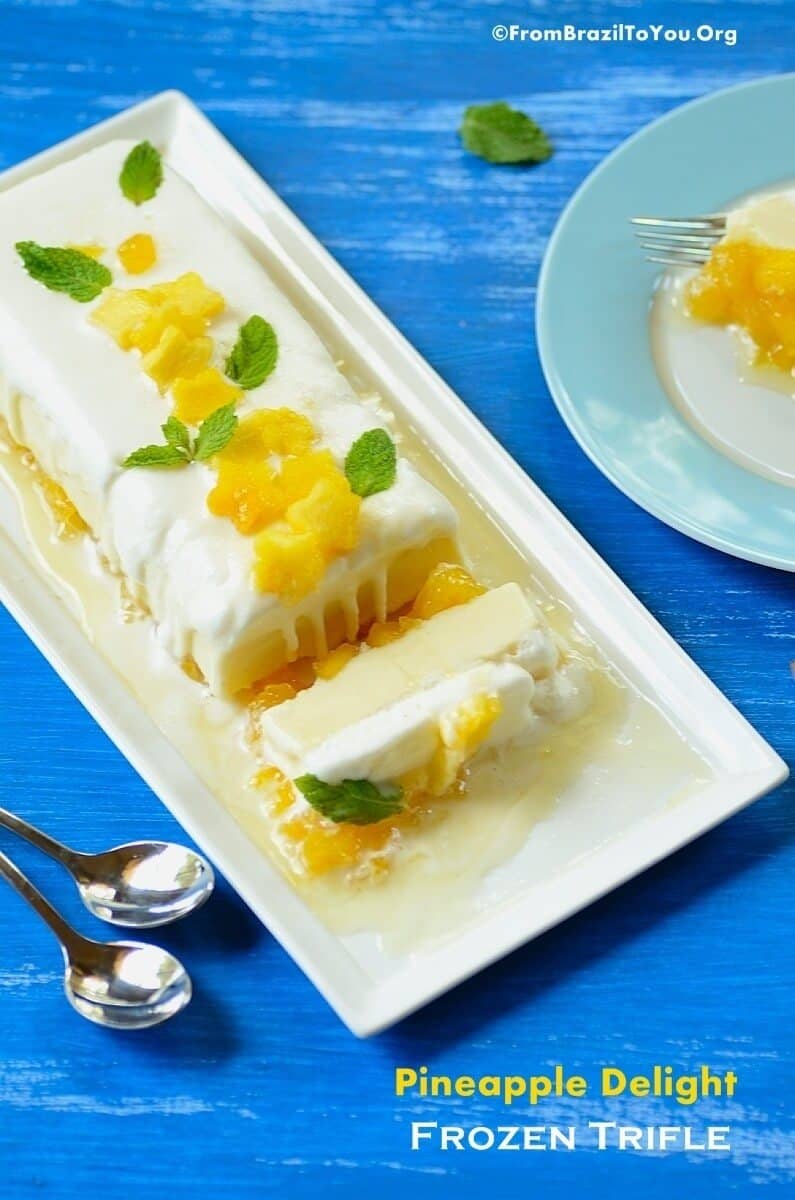 | A refreshing frozen tropical pineapple trifle. |
| Fio de Ovos | Sweet egg threads from Portugal served as dessert, toppings for cakes, and also a side for ham and turkey. | |
| Fruit compotes | 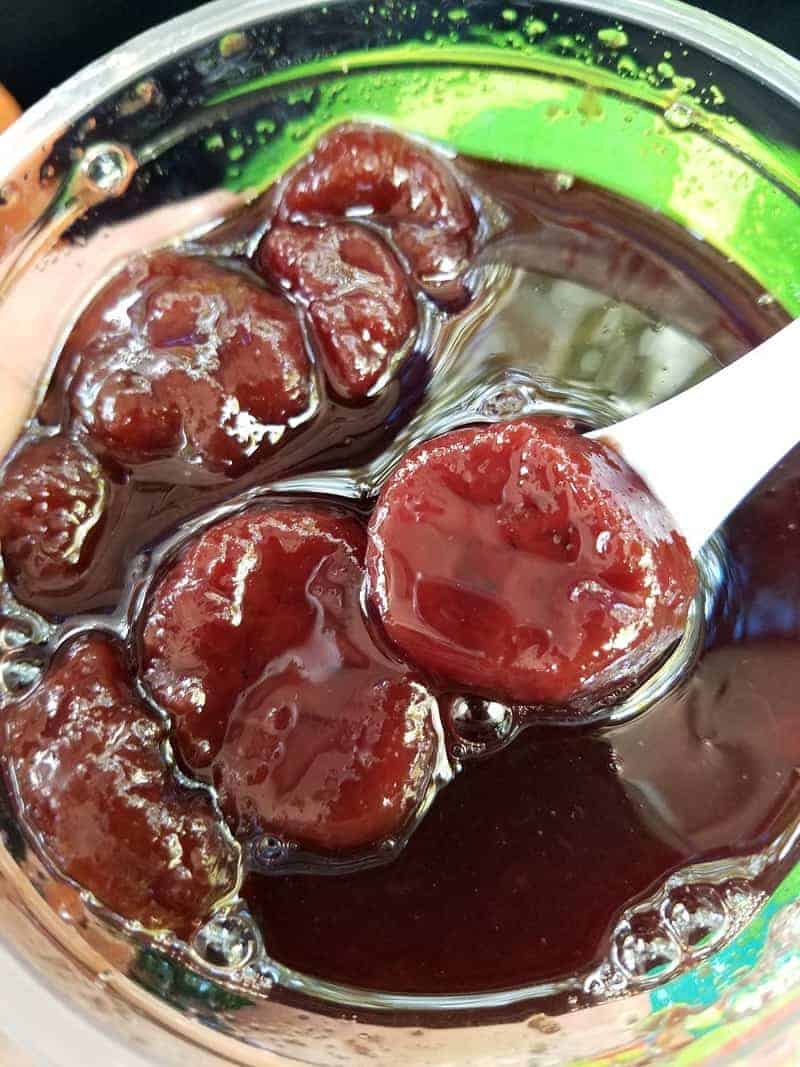 | Compotes made with bananas, guavas, limes, oranges, cashew fruit, etc.; influenced by Portuguese settlers. |
| Goiabada | 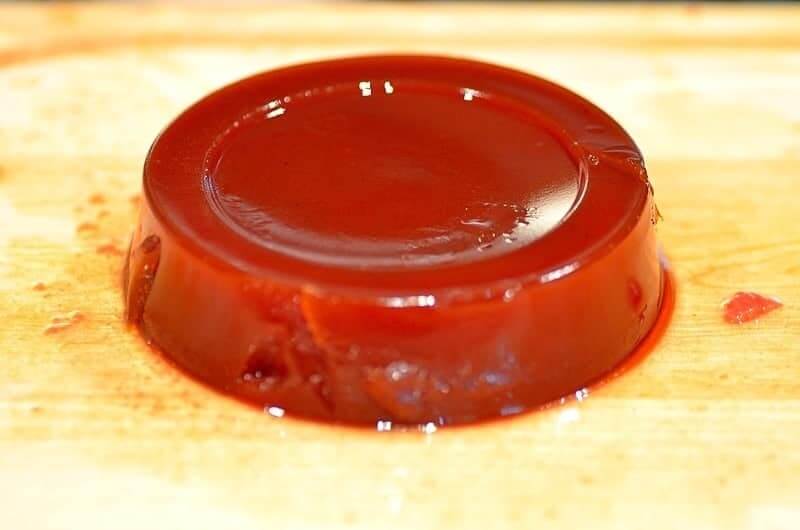 | Guava paste. |
| Pé-de-moleque |  | Peanut brittle. |
| Pão de mel |  | "Honey cake" -- Similar to a gingerbread, but these are filled with dulce de leche and covered with chocolate. |
| Pudim de leite |  | Caramel flan cooked in a ring pan. |
| Quindim | 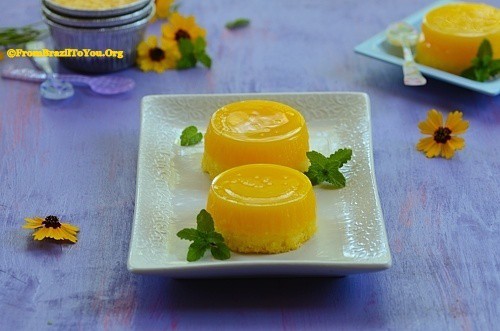 | A bright yellow custard made from egg yolks, sugar, and coconut flakes, resembling a mini flan. |
| Rabanada |  | Deep-fried french toast covered with cinnamon and sugar. |
| Rapadura | Whole cane sugar or jaggery. | |
| Mousse de maracujá | Passion fruit mousse. | |
| Paçoca | 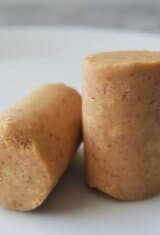 | Ground peanut candy, similar to the filling in a Reese's Peanut Butter cup. |
| Pamonha de forno | 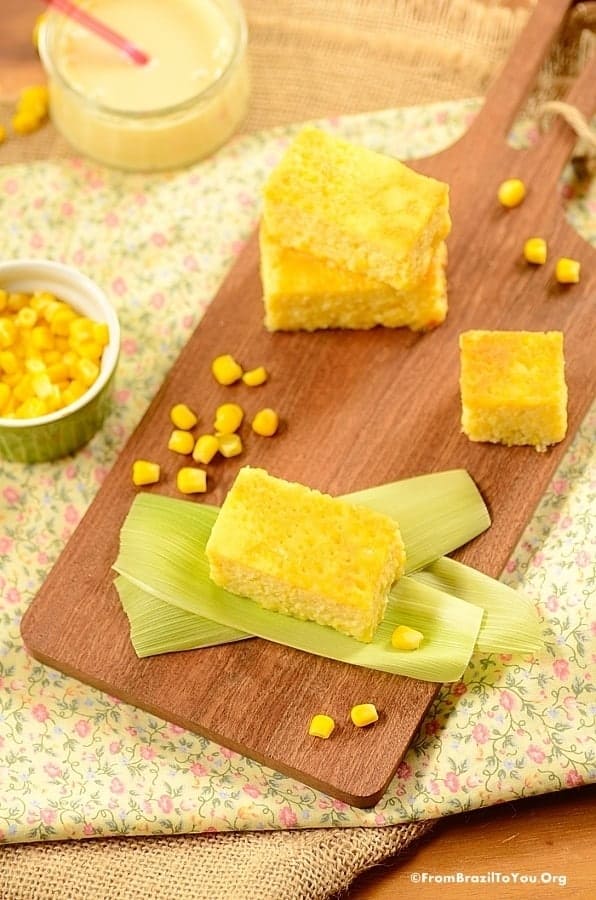 | The sweet version is a baked sticky corn cake that emulates the traditional dish wrapped in fresh corn leaves and boiled in water. |
| Pão Doce com Coco | 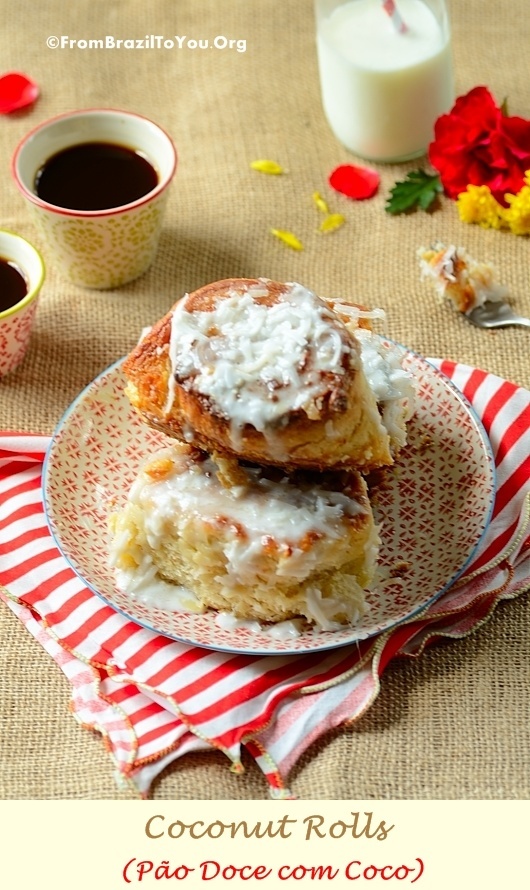 | Sweet coconut rolls |
| Pastel de nata | 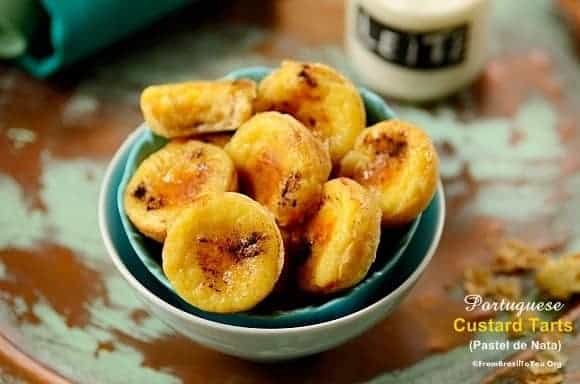 | Sweet custard tarts from Portuguese influence. |
| Pavê |  | Rich chocolate or fruit trifle with cookies. |
| Pudim de pão |  | Bread pudding with a flan-like consistency. |
| Queijadinha | 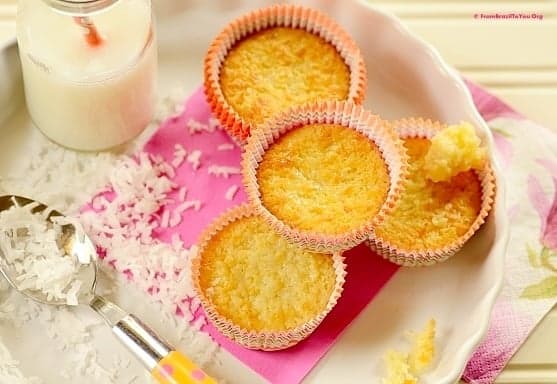 | Flourless coconut and cheese mini custard tarts. |
| Romeu e Julieta | Combination of guava paste with a mild cheese. | |
| Sagú de Vinho |  | Ruby-colored dessert made with red wine and sweet tapioca pearls. |
| Salada de frutas | 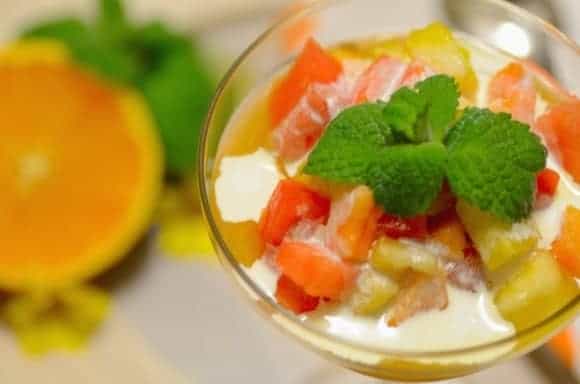 | Fresh fruit cocktail salad made with tropical fruit mixed with orange and lime juice |
| Sorvete Nata Goiaba |  | Rich vanilla ice cream suffused with fragrant guava sauce |
| Surpresa de uva/Uvinha | 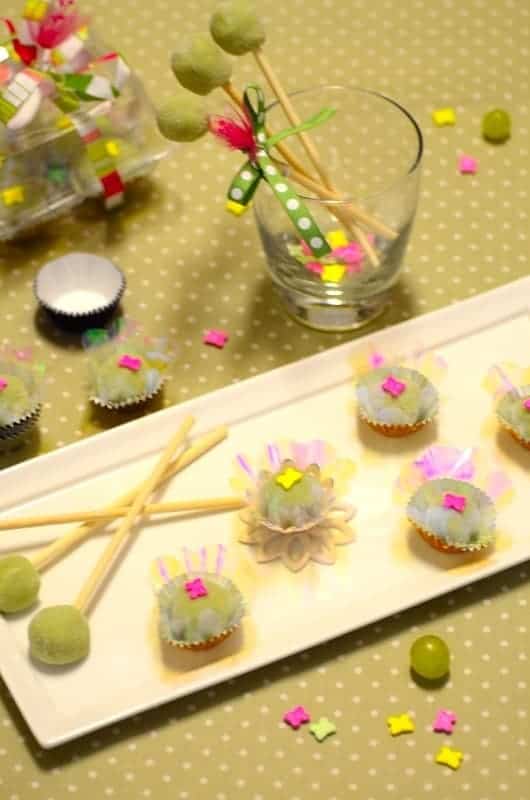 | Sweet/tangy candy made with grapes rolled in sweet white brigadeiro |
| Torta holandesa | 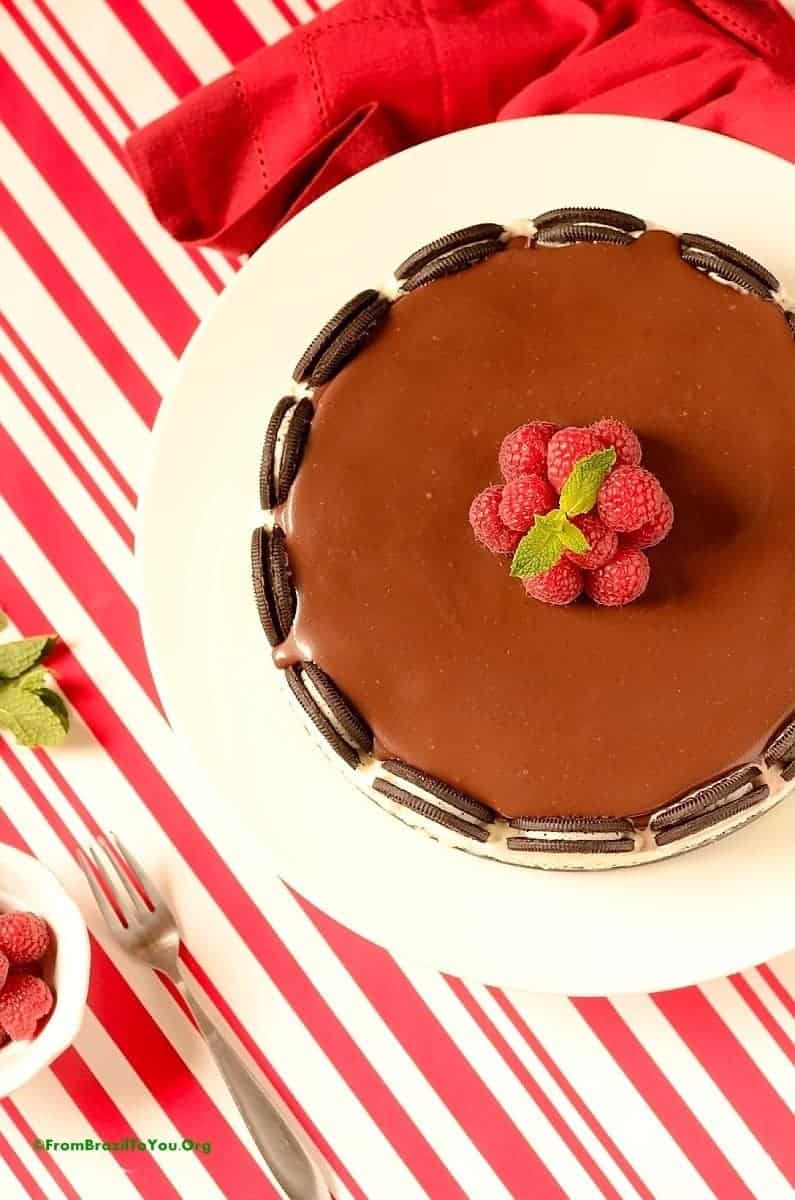 | Cookies and cream tart made with ice cream. |
Traditional Brazilian Drinks
| Name | Image | Description |
|---|---|---|
| Coffee | 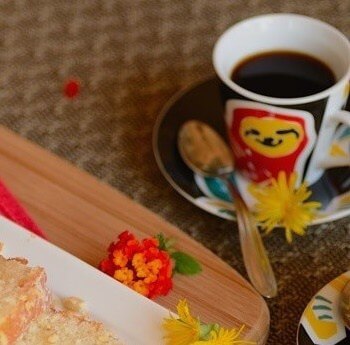 | Made from arabica coffee beans and quite strong. For this reason, it is mostly served in mini cups, called cafezinho. |
| Caipirinha | 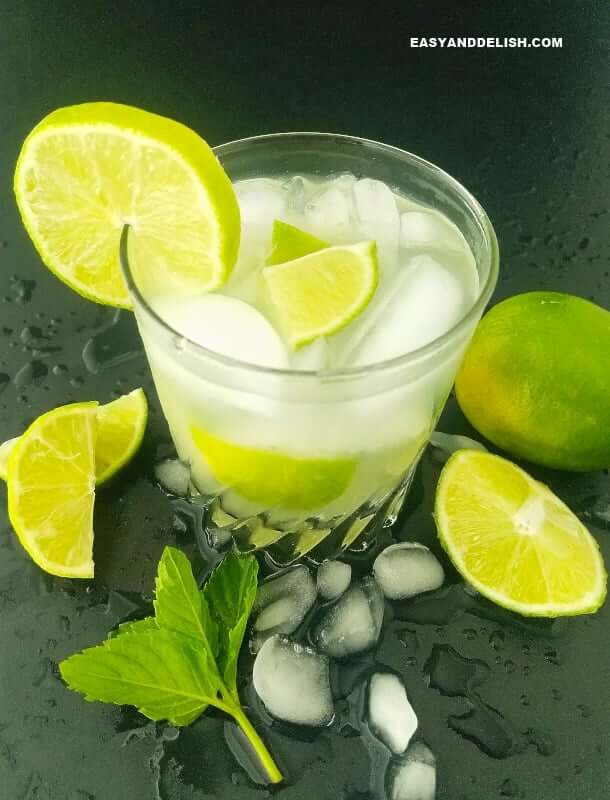 | Brazil's national cocktail made from cachaça and lime, with different fruit variations. |
| Chimarrão or Yerba mate | Mate tea served in a calabash gourd. | |
| Fruit juices | 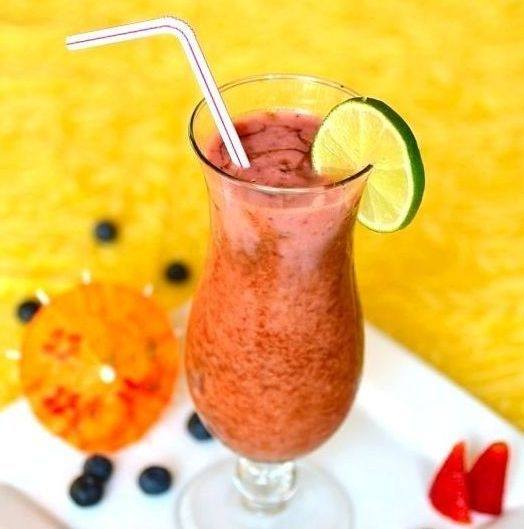 | Made fresh from various assorted fruits. |
| Guaraná soft drink |  | Carbonated beverage made from guaraná berry. |
| Beer (chopp) | Served super-chilled, influenced by German immigrants. | |
| Cana de açucar | Sugar cane juice. Very much a street drink, usually served with pastel. | |
| Limonada suíça | 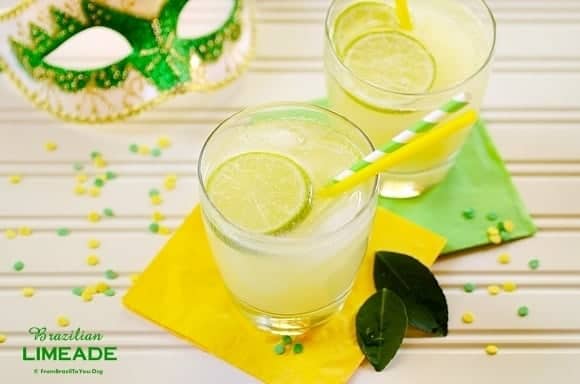 | Brazilian fresh limeade. |
"Guaraná" by Gustavo Facci is licensed under CC BY 2.0
Moreover, take a look at these 50 Easy Brazilian recipes and our Easy and Delish's complete index of Brazilian recipes.
To read more about classic Brazilian ingredients and their American subs for recipes, see here.
Regional Brazilian Foods
Notably, traditional Brazilian dishes and the typical ingredients that they use vary from one region to the next. In fact, sometimes they even differ between states from the same region, due to regional influences.
Regional cuisines of Brazil can be classified by geographical areas as follows:
North
Seven states -- Acre, Amazonas, Amapá, Pará, Rondônia, Roraima, and Tocantins-- where the largest influence is Indigenous. The cuisine is known for its heavy use of manioc (cassava) and its derivatives. Its use of freshwater fish (due to the Amazon River) and Amazonian fruits such as açai berry also stand out as traditional Brazilian foods.
Northeast
Nine states-- Alagoas, Bahia, Ceará, Maranhão, Piauí, Pernambuco, Paraíba, Rio Grande do Norte and Sergipe. This is the largest region, with African, Native, and Portuguese influences, although the predominance of each varies within each state.
Bahia, for example, shows more African influence than any other state. In addition, Dutch and Jewish influences shine through in the state of Pernambuco.
It’s a regional Brazilian cuisine heavy in seafood and coconut dishes, on account of its large coastline. The tropical climate also favored planting and use of cane sugar and whole cane sugar (rapadura). Plus, there are fruit compotes from the Portuguese, palm oil and black-eye peas from Africans, tapioca (manioc) flour from the Native tribes, and the Dutch Edam cheese (from which ‘queijo do reino’ is adapted), among others.
This region and the North region are also known for their gluten-free diet where vegetable roots, corn, and tapioca-based dishes are common, along with rice and beans, two of our most traditional Brazilian foods. This is in contrast to other regions that have more wheat-based dishes.
Mid-West
Three states -- Goiás, Mato Grosso, Mato Grosso do Sul and the capital of Brazil, Brasilia. The influences are mainly Portuguese and Native. The most well-known dishes are rice with pequi, galinhada (chicken and rice with pequi) and pamonha goiana (yellow corn tamales filled with cheese and sausage).
Southeast
Four states -- Rio de Janeiro, São Paulo, Espírito Santo and Minas Gerais. The largest cuisine influences here are Portuguese, Italian, Japanese, Lebanese, and some African and Native, depending on the state.
It’s a region known for pizza with outrageous toppings, pastas with requeijao and polenta with chicken. Other foods typical from this region are feijoada and its sides, brigadeiros recipe, sushi with tropical fruits, fried cassava, fried empanadas, kibbeh, and seafood stews like moqueca capixaba.
Southern
Three states -- Parana, Santa Catarina, and Rio Grande do Sul. This region has mainly European influence (Italian, German, Spanish, and Polish). Churrasco, chimarrão, wine, pirogi, and colonial breakfasts with German pastries are some of the most popular foods there.
Authentic Brazilian Meals in Restaurants
Although you can find diverse ethnic food restaurants in most of the country, traditional Brazilian foods and fusions are quite popular in Brazil. Depending on the setting, it can be ordered by:
- Por quilo (the price of a plate of food depends on its weight in kilos), is a type of service that is common in commercial areas near business offices, downtown, and in malls. This usually features a buffet style set-up and there is often a wide variety of regional dishes.
- A la carte in more refined restaurants and mall eateries.
- Rodizio style (all-you-can-eat, fixed price), seen at steakhouses, pizzerias, and sushi places.
Brazilian Daily Meals & Staples
In general, Brazilians tend to have 5 to 6 meals a day such as:
Breakfast
Breakfast foods in Brazil vary by region. In the North, people tend to have a heavy breakfast, such as açai bowl with manioc flour, fried fish and shrimp.
In contrast, in the Northeast Brazilian tapioca, scrambled eggs with corn couscous, and boiled vegetable roots with melted butter are staples.
Colonial breakfasts with a wide variety of cakes and pastries are common in the South such as apple crumb cake. This is especially true in Rio Grande do Sul where there is great German influence.
In the Southeast region, breakfasts tend to be lighter. This could be something like a cup of coffee, toast, and a piece of fruit. However, personal choices also apply, such as yogurt, cereal, fruit juices, eggs, and cheeses, etc.
Morning snack
This usually consists of leftovers from breakfast or something light, like a piece of fruit.
Lunch
For sure, lunch is the heaviest meal of the day. Regional differences stand out at lunchtime. But most of the country has rice and beans as a staple. The combo is served with animal protein (mostly beef, chicken, or seafood) and cooked or fresh vegetables.
Those with less financial means or who eat vegetarian recipes replace meat with a piece of fruit, like pineapple or banana. To give more substance, mix manioc flour or corn couscous with beans, and/or have a vegetable root (yuca or yam) as well.
Many who work in large cities either have lunch at buffets where the food price varies by weight (por quilo), or order lunch delivery to the office, such as "Chinese" food. By the way, there has been a wave of Chinese immigration to Northeast Brazil in recent years. Quite a few of these immigrants own buffets that feature regional Brazilian cuisine.
Afternoon snack
For many, snack consists of a sweet treat or savory pastries (salgados) such as coxinha and pastel, two of our most popular traditional Brazilian foods.
Dinner
In contrast to lunch and breakfast, dinner is usually the lightest of the 3 main meals. Dinner often features soups, salads, grilled meat, healthy sandwiches, or leftovers from breakfast or lunch, in small amounts.
Late snack
Not very common, but some will have something light, like fruit juice or yogurt.
Conclusion
To sum up, this has been an overview of popular traditional Brazilian foods. As shown above, traditional Brazilian food is an adventure for the senses, conquering all who have tried its rich, diverse dishes.
Back to the Easy and Delish Resources pages here.
Traditional Brazilian Food FAQs
What are some popular traditional Brazilian foods?
15 of the top traditional Brazilian foods include:
--Feijoada, a rich hearty bean stew with several cuts of pork, which is widely considered to be the national dish of Brazil.
--Moqueca baiana, a seafood and vegetable stew typical of Bahia State
--Tapioca crepes, made from tapioca flour, water, and salt, with either savory or sweet fillings
--Pão de queijo or cheese rolls made of tapioca flour, eggs, and cheese.
--Churrasco, or grilled meats, including picanha and other cuts of beef, pork, and chicken. Churrascarias or Brazilian steakhouses have become popular all over the world.
--Brigadeiros, or Brazilian truffles are the most beloved sweet treats. These chocolate fudge balls are very popular at festive events like birthday parties.
--Coxinha, deep fried chicken fritters very popular at snack bars and parties
--Pastel de carne, fried or baked empanadas filled with ground beef
--Salpicão, chicken salad with carrots, raisins, and ham
--Acaraje, black-eyed pea fritters filled with dried shrimp and a spicy creamy paste called vatapá
--Feijão tropeiro, beans with manioc flour
--Requeijao, Brazilian cream cheese spread
--Quindim, a bright yellow custard made from egg yolks, sugar, and coconut flakes
--Mousse de maracujá. a condensed milk passionfruit mousse
--Creme de papaya, or papaya cream, a delicious blend of ice cream and papaya
What are some typical ingredients used in cooking traditional Brazilian food?
Typical Ingredients:
Nuts -- cashews, Brazil nuts, peanuts, and pine nuts (pinhão)
Vegetables -- cassava, yams, corn, okra; palmito (hearts of palm)
Fruits, mostly tropical -- cashew fruit, açai, guaraná, banana, custard apple, acerola, pitanga, coconut, guava, mango, pineapple, papaya, passion fruit, coffee, pequi, and so many others
Meats -- a large variety of seafood, poultry, pork, and beef
Dairy -- mostly cow's milk and typical cheeses such as requeijão, coalho, Catupiry, and Minas
Legumes -- beans (black, pinto, soybeans, garbanzo)
Grains -- several types of rice, wheat, and cornmeal
Grass -- sugar cane
Others -- tapioca, palm oil (or dende)
What are restaurants like in Brazil?
Besides many ethnic food restaurants, traditional Brazilian food and fusions are quite popular in Brazil. Depending on the setting, foods can be ordered by:
1. Por quilo: the price of a plate of food depends on its weight in kilos, a type of service which is common in commercial areas near business offices, downtown, and in malls. This usually features a buffet style set-up and there is often a wide variety of regional dishes.
2. A la carte: in more refined restaurants and mall eateries.
3. Rodizio style: all-you-can-eat, fixed price dining, seen at steakhouses, pizzerias, and sushi places.
How many meals a day do Brazilians have?
In general, Brazilians tend to have 5 to 6 meals a day, which may include: breakfast, morning snack, lunch, afternoon snack, dinner, and a late snack.
What is a typical breakfast in Brazil?
Breakfast foods in Brazil vary by region. In the North, people tend to have a heavy breakfast, such as açai bowl with manioc flour, fried fish and shrimp.
In contrast, in the Northeast tapioca crepes with cheese, scrambled eggs with corn couscous, and boiled vegetable roots with melted butter are staples.
Colonial breakfasts with a wide variety of cakes and pastries are common in the South. This is especially true in Rio Grande do Sul where there is great German influence.
In the Southeast region, breakfasts tend to be lighter. This could be something like a cup of coffee, toast, and a piece of fruit. However, personal choices also apply, such as yogurt, cereal, fruit juices, eggs, and cheeses, etc.
What is a typical lunch in Brazil?
Lunch is usually the heaviest meal of the day in Brazil. Regional differences really stand out at lunchtime., but most of the country has rice and beans as a staple. The combo is served with an animal protein (mostly beef, chicken, or seafood) and cooked or fresh vegetables.
Those with less financial means or vegetarians replace meat with a piece of fruit, like pineapple or banana. To give more substance, some mix manioc flour or corn couscous with beans, and/or have a vegetable root (yuca or yam) as well.
Many who work in large cities either have lunch at buffets where the food price varies by weight (por quilo), or order lunch delivery to the office, such as "Chinese" food.
What is a typical dinner in Brazil?
In contrast to lunch and breakfast, dinner is usually the lightest of the three main meals. Dinner often features soups, salads, grilled meat, healthy sandwiches, or leftovers from breakfast or lunch, in small amounts.
What is the national dish of Brazil?
Feijoada is widely considered to be the national dish of Brazil. Feijoada is a hearty, savory stew of assorted meats mixed with beans, usually black beans.
What do Brazilians eat for dessert?
Most Brazilian desserts, as is the case of many Latin American desserts, are based on condensed milk, and include brigadeiro, brigadeirao, beijinho, queijadinha, passionfruit mousse, and flan. Some others are very regional dessert recipes such as quindim, bolo de rolo, cocada, Brazilian carrot cake, bolo de tapioca, cuca de maçã, and sagu de vinho.
PIN AND ENJOY!
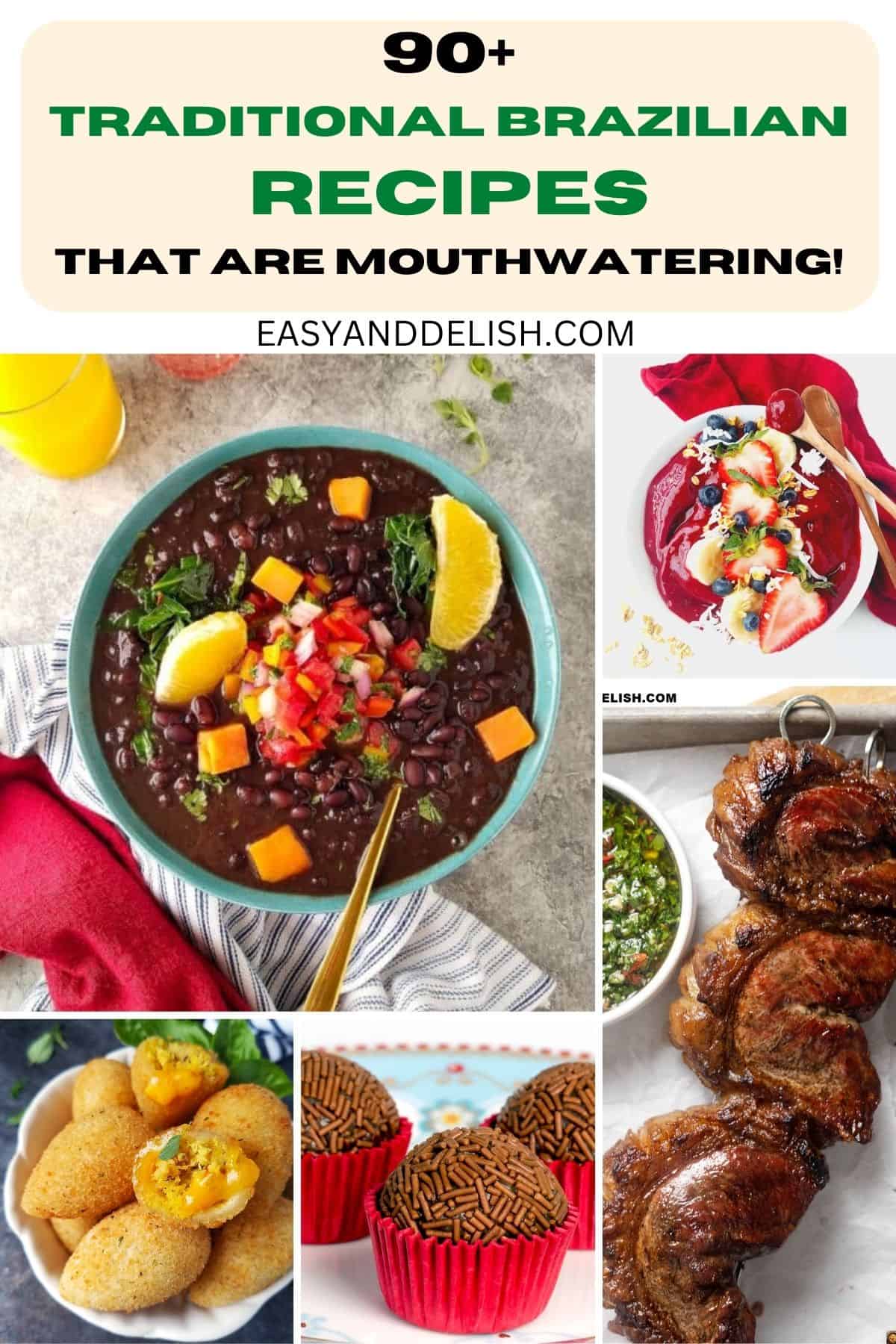
90+ Traditional Brazilian Foods That Are Mouthwatering
Equipment
- 1 charcoal grill
- 2 skewers
- 1 knife
- 1 cutting board
- 1 bowl only if making the sauce
- 1 spoon only if making the sauce
Ingredients
- 2-3 lbs picanha roast I used USDA CHOICE because it is cheaper and is still tender (other names: top sirloin cap, rump cover, rump cap, or culotte). NOTE: Do NOT remove the fat cap! Because it is a tender cut, there is no need to pay more for a USDA prime and much less for a Wagyu.
- 2-3 tablespoon of rock salt or 1 tablespoon per pound of meat
SERVE WITH:
- Chimichurri sauce Recipe in the notes (OPTIONAL)
- Lime wedges
Instructions
- SLICE THE PICANHA ROAST: Do NOT remove the fat cap!!! Instead, score the cap of fat in a crosshatch pattern, NOT cutting too deeply. Slice the roast into 1.5-2-inch steaks on an angle perpendicular to the fibers running diagonally through the picanha.
- Depending on the size of your roast, it may yield 5 or more steaks. If you bought the picanha already sliced, you won’t need to slice it but score the fat cap!
- SKEWER AND SEASON: Fold each picanha steak in half or C-shape and then skewer each through 2-metal skewers with the fat side down on the outside of the skewers. Next, season the steaks all over with the salt. Let them sit at room temperature while firing up your grill! NOTE: Depending how long or short your skewers are, skewer only 2-3 steaks per skewer/double-skewer!
- PREP THE CHARCOAL GRILL: Clean the grates of your grill. Set a two-zone grilling (hot and cool zones) if you don’t have a rotisserie. Use lump charcoal to give the meat a more authentic profile flavor! Preheat your charcoal grill at high heat (500 degrees F OR 260 degrees C). Carefully, oil the grates of your grill!
- GRILL THE PICANHA STEAKS: Place the steaks directly between your hot and cool zones. Make sure to flip the skewers every 2-3 minutes, closing the lid in between flipping. This will help the steaks to be cooked more evenly.
- Begin to check their internal temperature with a meat thermometer after 15 minutes of cooking. It’ll take about 20-25 minutes to cook them to rare to medium-rare (125-130 degrees F (or 52-54 degrees C). The middle of the steaks will rare and the outside will be medium-rare.
- LET THEM REST: Remove the meat skewers from the grill, tap them with the side of a knife to remove any extra rocks of salt (not dissolved), and let the steaks rest for 5 minutes, tented with a foil, before slicing to allow their juices to distribute.
- SLICE AND SERVE: Use a sharp steak knife to slice the meat right off the skewer directly onto plates. Serve with chimichurri sauce and lime wedges on the side! NOTE: Brazilians usually eat the fat cap as well (it is flavorful) but you can make that choice for yourself.
Recipe Video

Recipe Notes
- ½ cup olive oil
- 2 tablespoons red wine vinegar
- ½ cup finely chopped parsley
- 4 cloves garlic, minced
- 1 small red chili, de-seeded and finely chopped
- ¾ teaspoon dried oregano
- 1 teaspoon coarse salt
- ½ teaspoon of black pepper
- Fridge: Once completely cooled, transfer leftovers to an airtight container and store them in the fridge for up to 3 days.
- Freezer: This easy freezer recipe can be transferred to a sealed plastic bag or airtight container and stored for up to 2 months.
- Thaw: Thaw the steaks in the fridge overnight if you want to reheat them the next day.
- Reheating: You can reheat the steaks in the microwave in 30-second intervals on medium heat. Remember to flip them in between. It’s best to add a little water (or steak sauce) to a microwave-safe dish so they don’t dry out. Just know the steaks won’t be medium-rare again when you reheat them.
Nutrition
** Nutrition labels on easyanddelish.com are for educational purposes only. This info is provided as a courtesy and is only an estimate, since the nutrition content of recipes can vary based on ingredient brand or source, portion sizes, recipe changes/variations, and other factors. We suggest making your own calculations using your preferred calculator, based on which ingredients you use, or consulting with a registered dietitian to determine nutritional values more precisely.
Please note that health-focused and diet information provided on easyanddelish.com is for educational purposes and does not constitute medical advice, nor is it intended to diagnose, treat, cure, or prevent disease. Consult with your doctor or other qualified health professional prior to initiating any significant change in your diet or exercise regimen, or for any other issue necessitating medical advice.





